February 8.
Breakfast at the hotel before heading back toward the international airport with Ana (and her husband, Freddy) for a 40-minute flight to the Caribbean coast and our final destination, Cartagena.
We are met at the airport by a Juan Camilo, who just graduated from college two years ago. We are staying at a beautiful, boutique hotel, Casa San Agustin, right in the heart of the “ciudad amurallada,” the old walled city of Cartagena. Here we encounter quaint streets and plazas lined with bright yellow and blue walls of buildings that define the colonial architecture of this 500-year-old city.
After getting settled, we drive to the Castillo de San Felipe de Barajas, one of the largest Spanish colonial fortresses ever built. For regulatory reasons, we are accompanied by a second guide, José, who adds nothing. Juan Camilo is energetic and fun, and entrepreneurial. He studied and speaks both English and French. 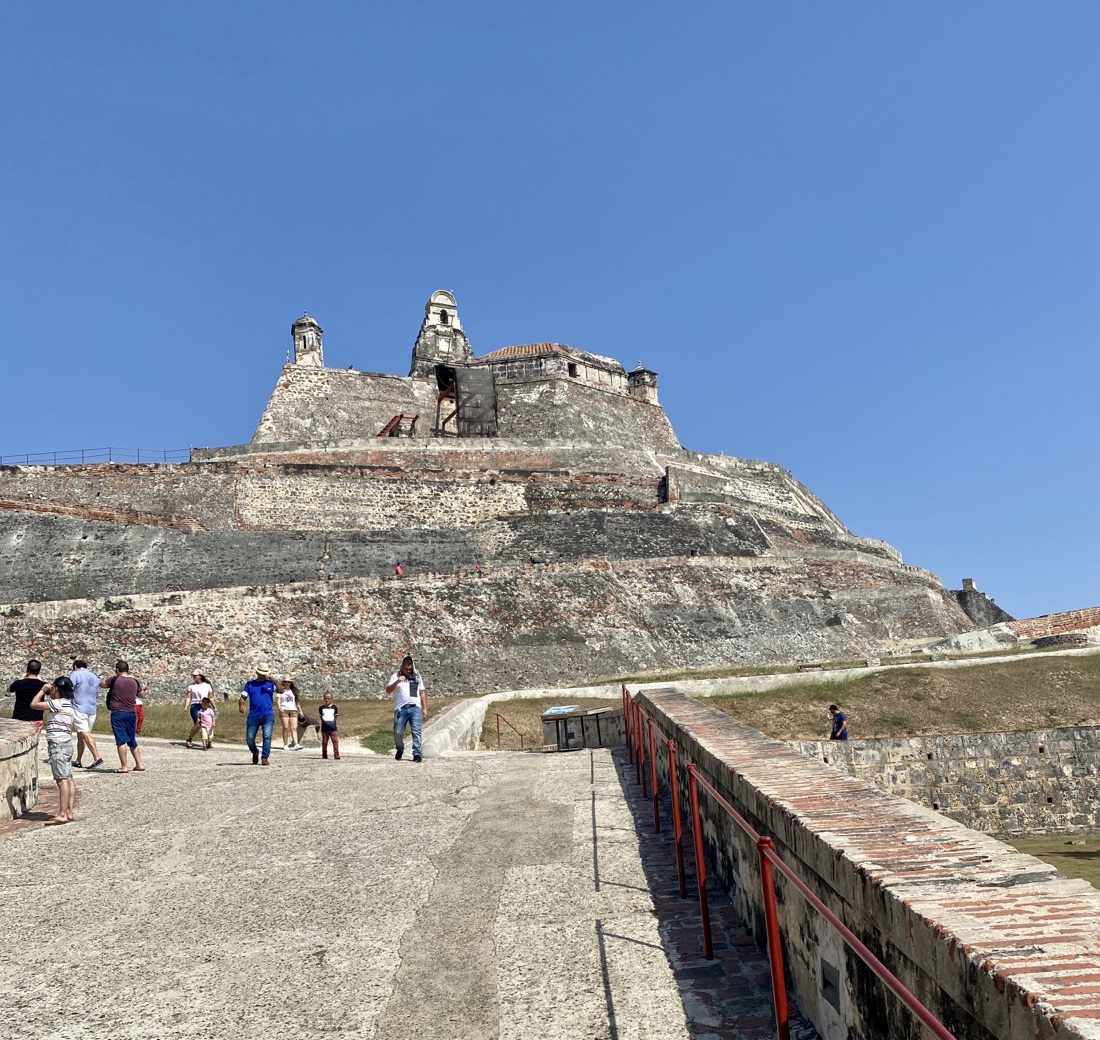 As we walk part way up the walls of the fort we can understandwhy, despite several attempts by outside forces, the Castillo de San Felipe was never taken and always successfully defended. It is extremely hot out, so, mercifully, we are able to stop at an air conditioned room that has a quite interesting film about the construction and history of the fort. As we walk part way up the walls of the fort we can understandwhy, despite several attempts by outside forces, the Castillo de San Felipe was never taken and always successfully defended. It is extremely hot out, so, mercifully, we are able to stop at an air conditioned room that has a quite interesting film about the construction and history of the fort.
Because of the heat, we decline to climb up farther on the fort walls. We drive back into the walled city and see more of its quaint, but touristy, town. 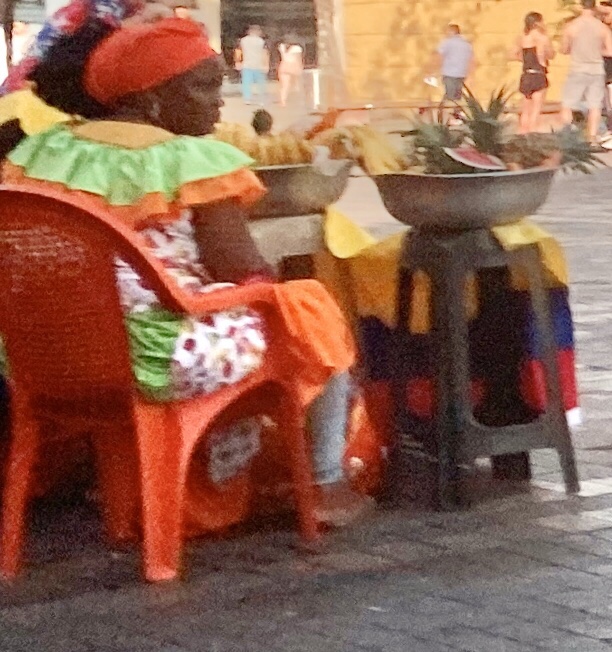 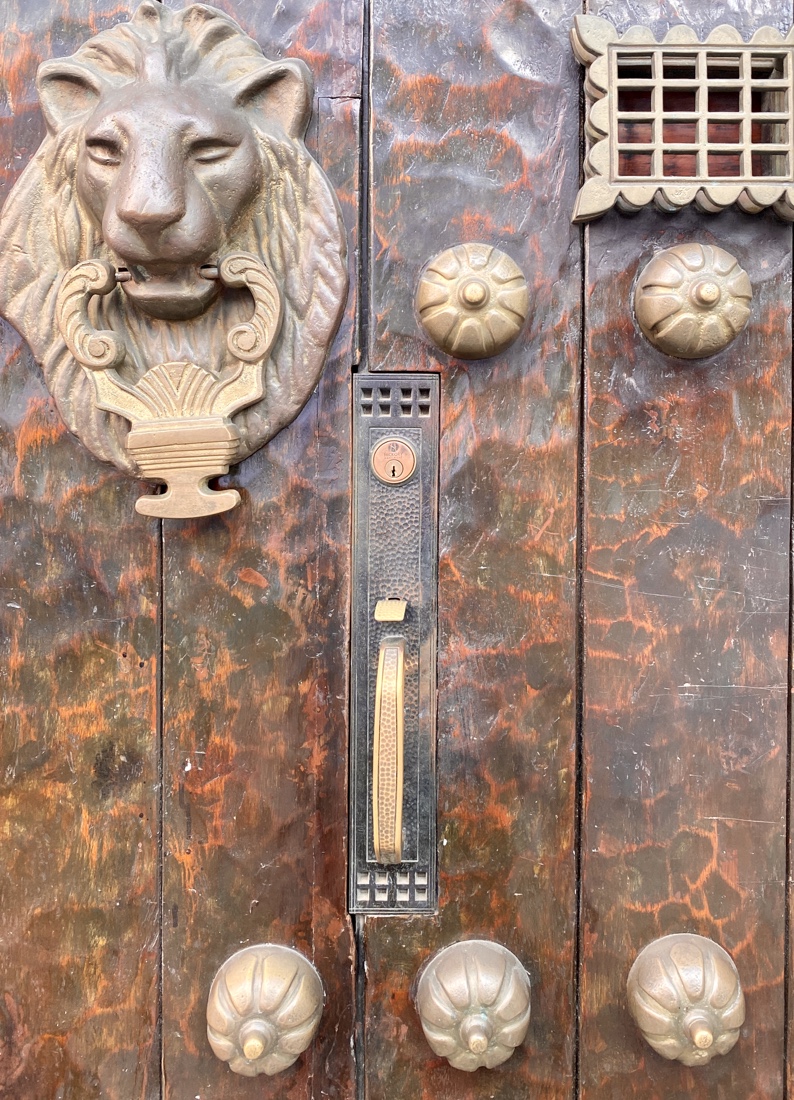 Cartagena clearly has more hats for sale per capita than any city we’ve seen. Cartagena clearly has more hats for sale per capita than any city we’ve seen. Juan Camilo tells us rather more than we care to hear about the history of the area, and some of the spots we were to see were not open. We do stop at a nice coffee shop, which reportedly has won more prizes for its coffee than any other, then return to our hotel, ready to call it a day. We are shown to our suite, which is very lovely, superior by far to the presidential suite at the Park 10 in Medellin. Juan Camilo tells us rather more than we care to hear about the history of the area, and some of the spots we were to see were not open. We do stop at a nice coffee shop, which reportedly has won more prizes for its coffee than any other, then return to our hotel, ready to call it a day. We are shown to our suite, which is very lovely, superior by far to the presidential suite at the Park 10 in Medellin.
Have been emailing and What’s Apping all day with Federico Ruiz, the art dealer we spent a day with in Bogotá. He and his wife, Rochi, are on an island off of Cartagena and we are trying to arrange to have dinner together tomorrow.
After resting in our room, we drive to dinner at Celele’s, where Brian has arranged a table for us. This is a very unusual, funky place that Brian, as a big foodie, knew about. It’s description, in the menu, said,”Contemporary cuisine based on the gastronomic culture and biodiversity of the Colombian Caribbean territory. “. The food was interesting; some of it very good, some not so much. The place was buzzing; completely full and probably seven tables turned away, with a second seating yet to come. Servers were very cute.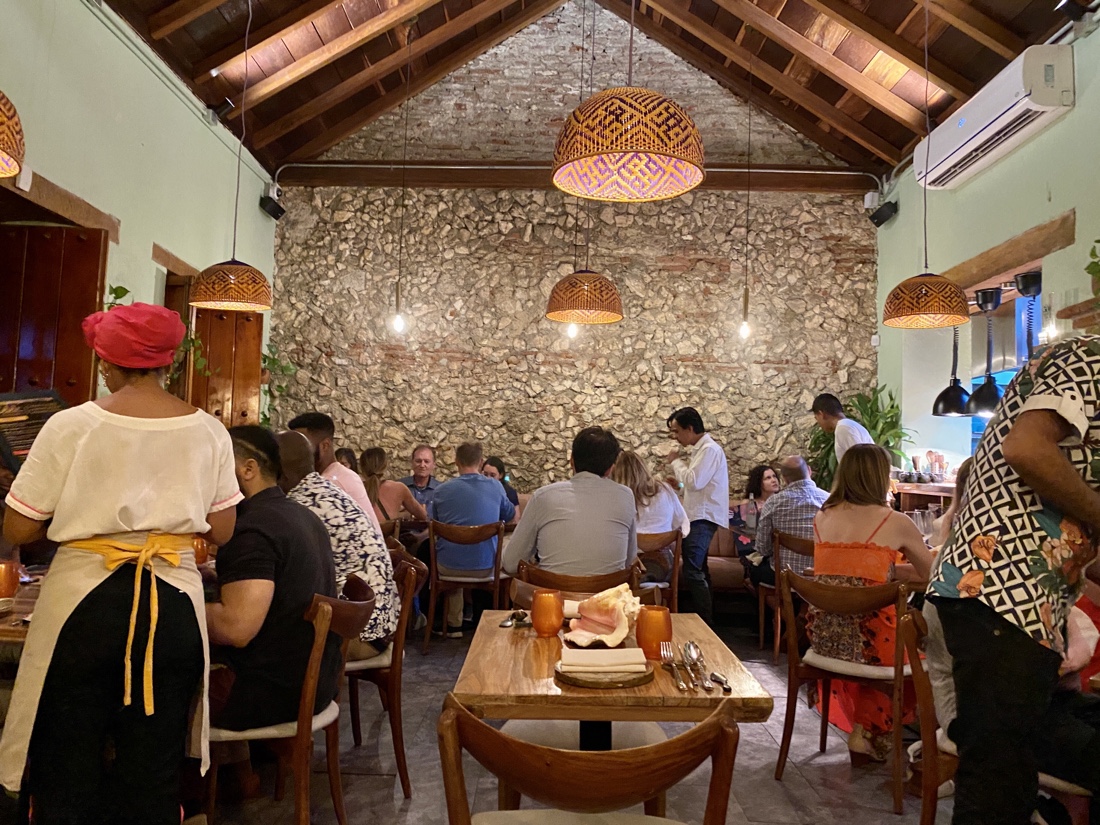 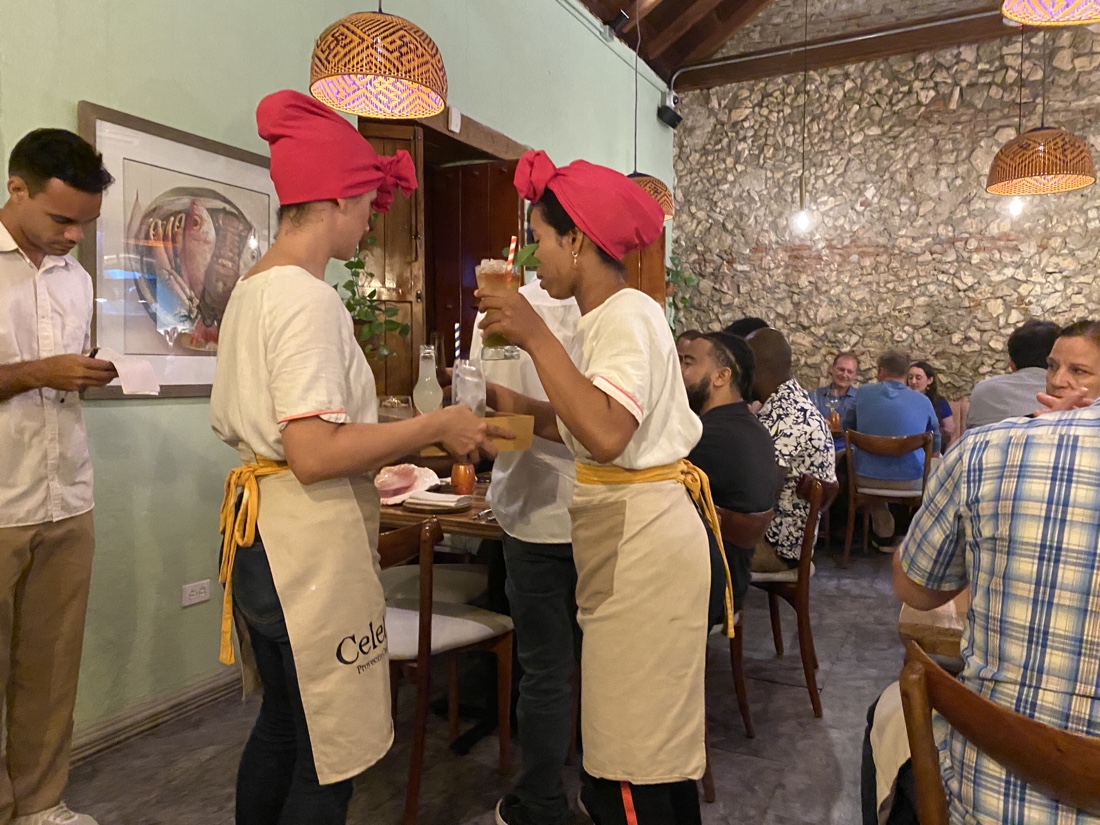 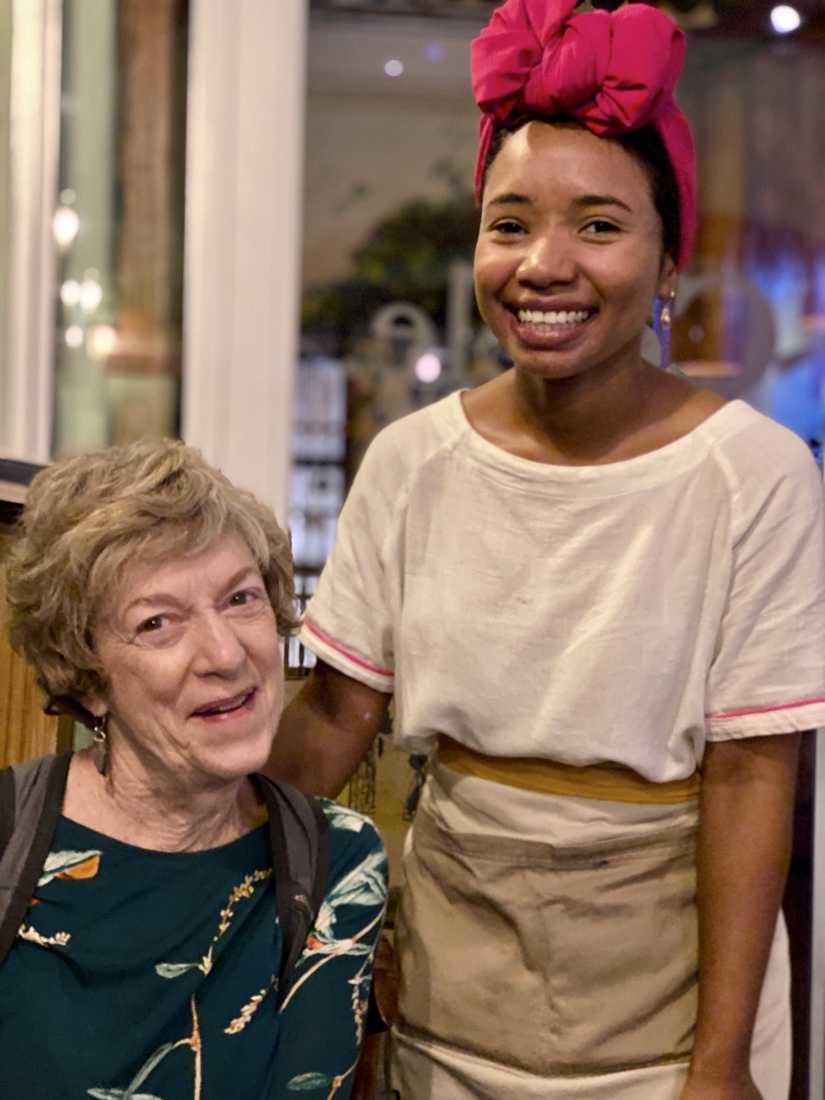 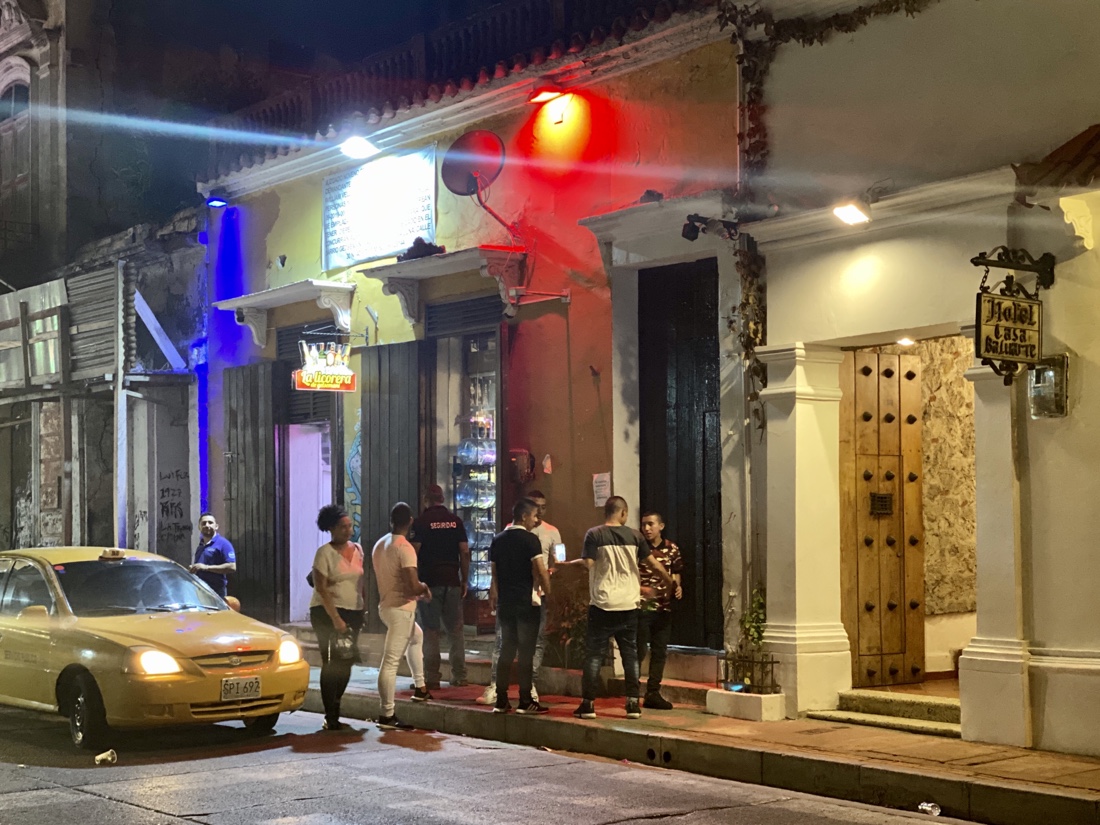
All in all, this was the least interesting day we’ve spent in Colombia. History is just not as interesting as people. But still, not bad. Returned to the hotel to retire.
February 6.
In the morning we drive two hours for a special, private experience, arranged by Brian and his travel company, True Colombia Travel. In the past couple days, we have have moved from Medellin to Cannúa (Brian’s lodge) and Santa Elena, where we saw the flowers, and today to to Fredonia (which sounds to me as if it comes straight out of a Gilbert & Sullivan operetta) in the Southwest.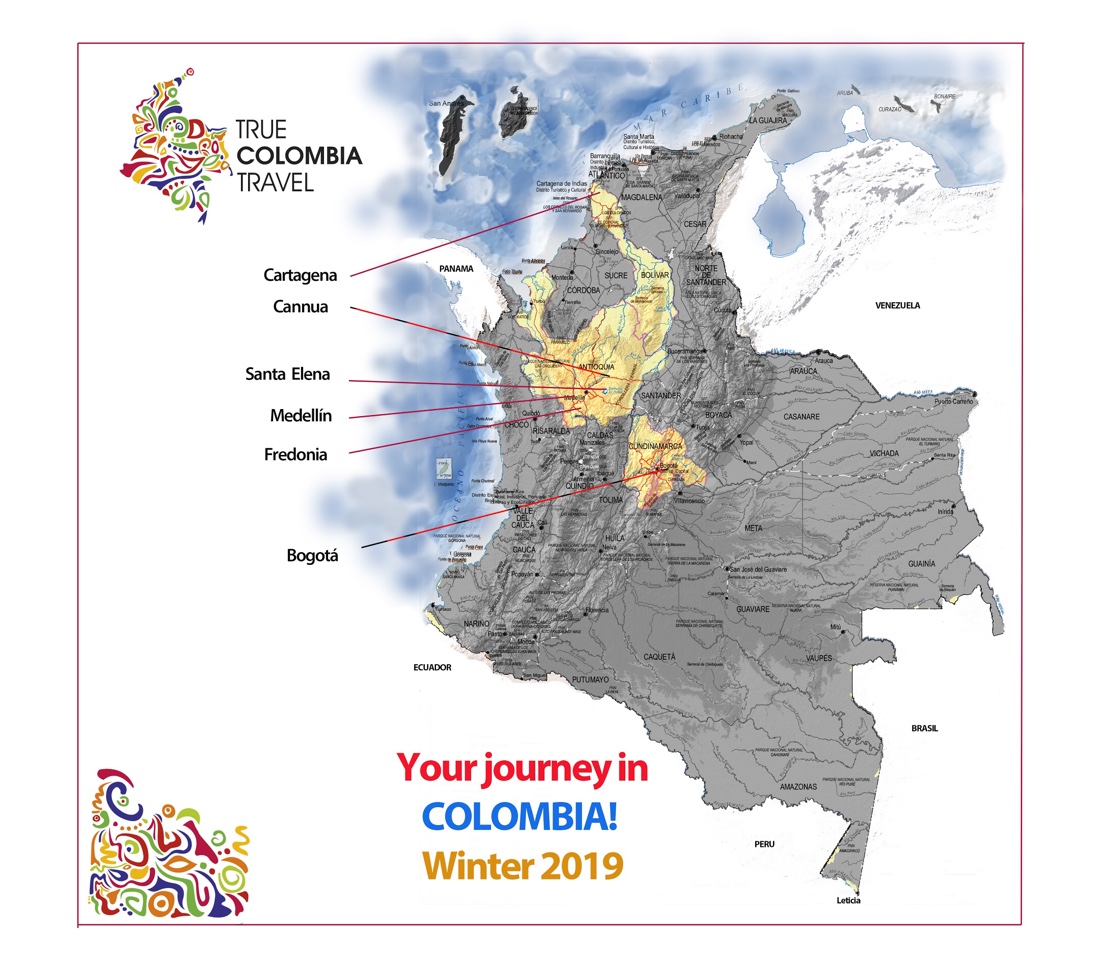 En route to our destination, we pass through some small towns. En route to our destination, we pass through some small towns.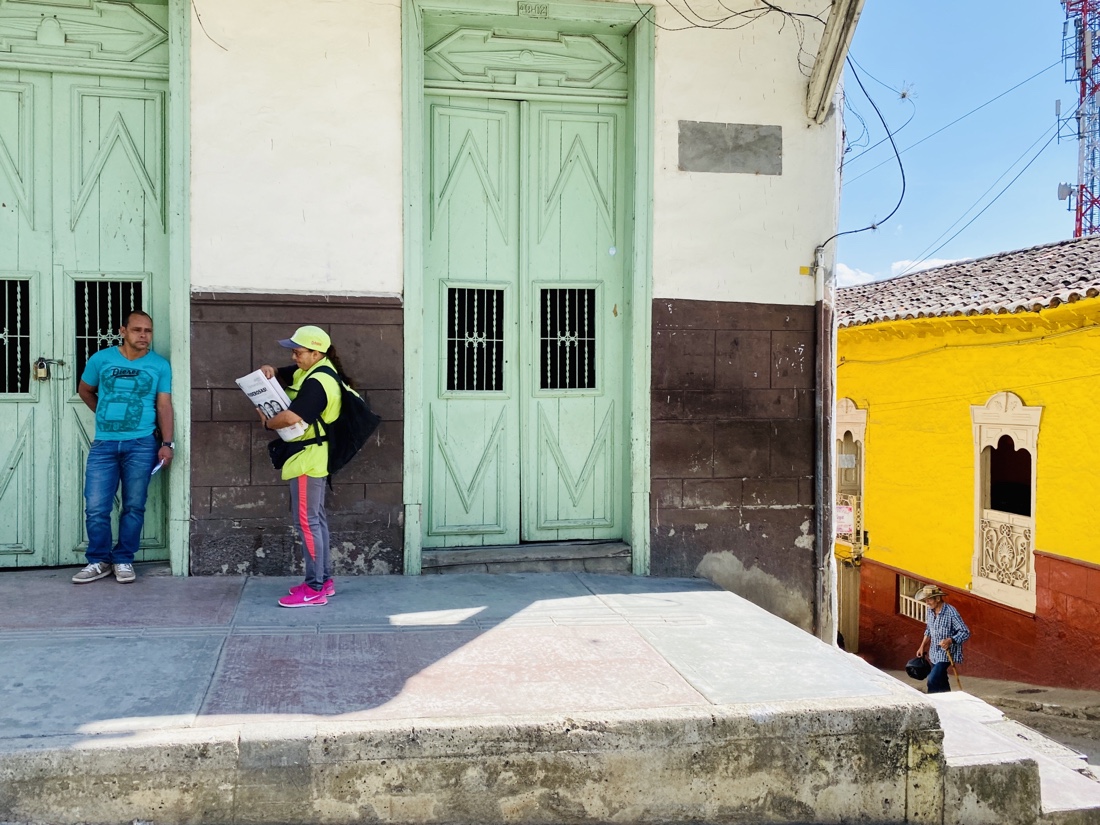 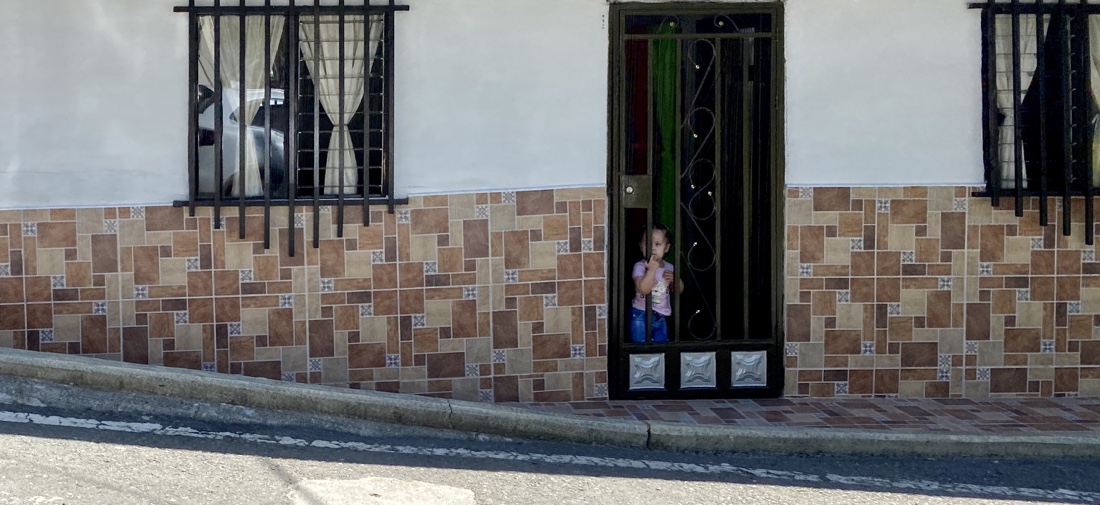 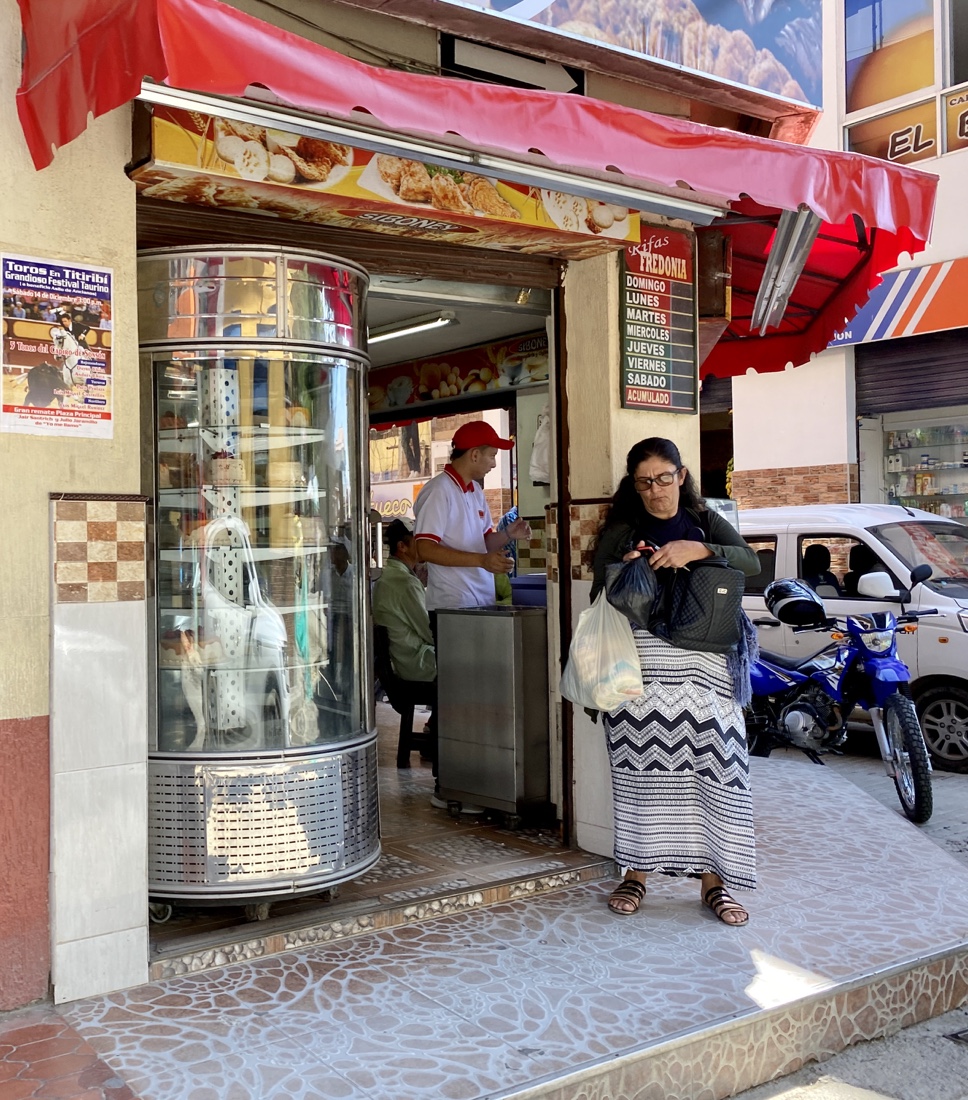 
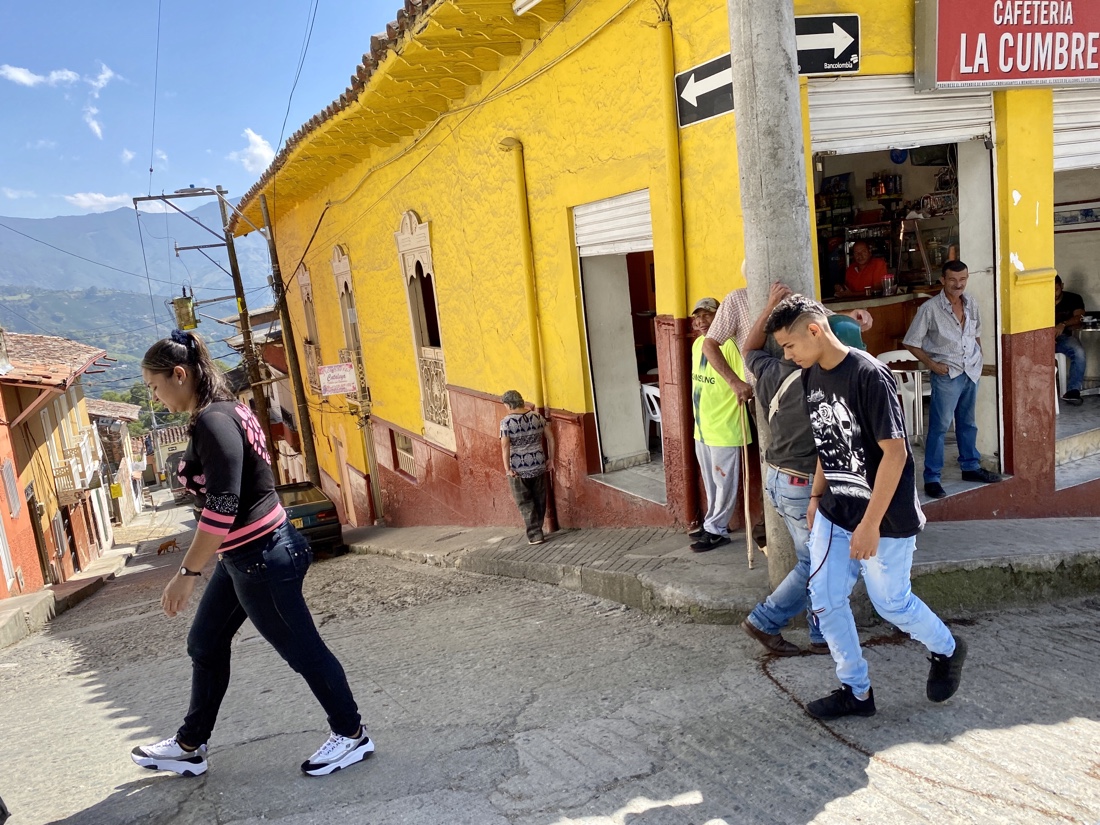 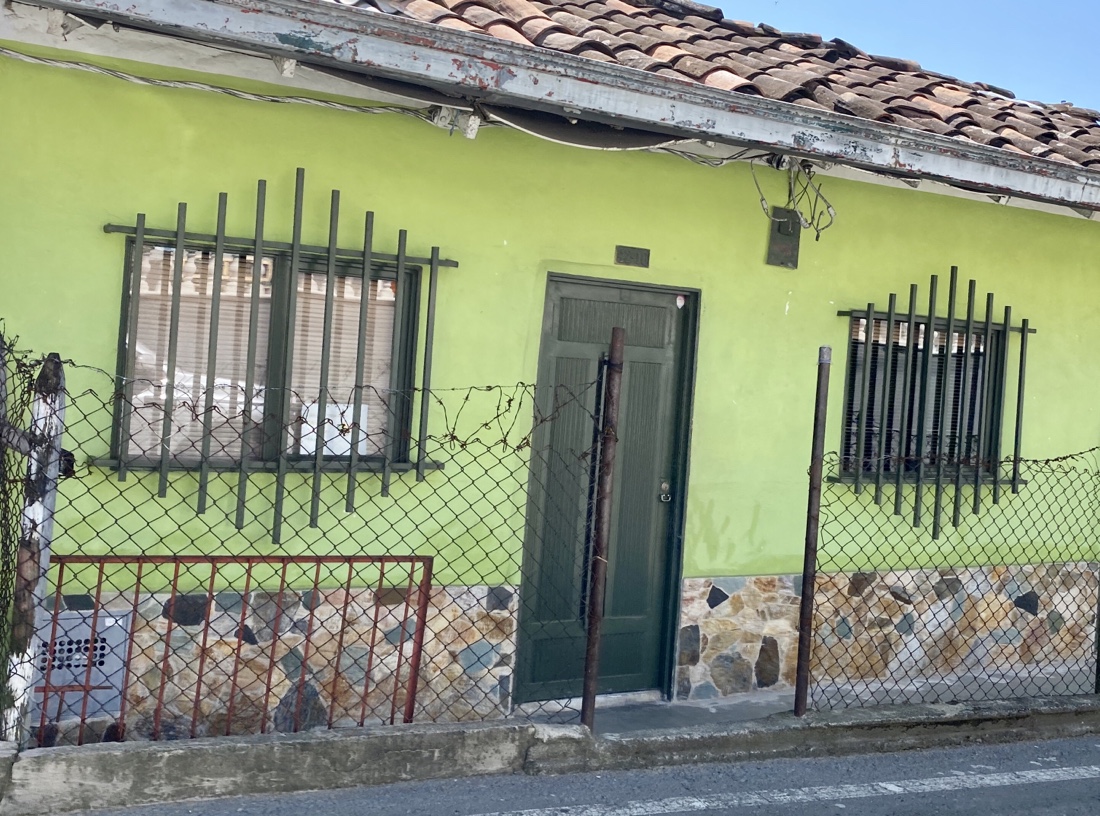 Over 120 years ago, the very first commercial coffee cultivations in Colombia were planted in this beautiful finca (farm) in San Cayetano, which today produces some of the best traditional coffee in the country. Over 120 years ago, the very first commercial coffee cultivations in Colombia were planted in this beautiful finca (farm) in San Cayetano, which today produces some of the best traditional coffee in the country. 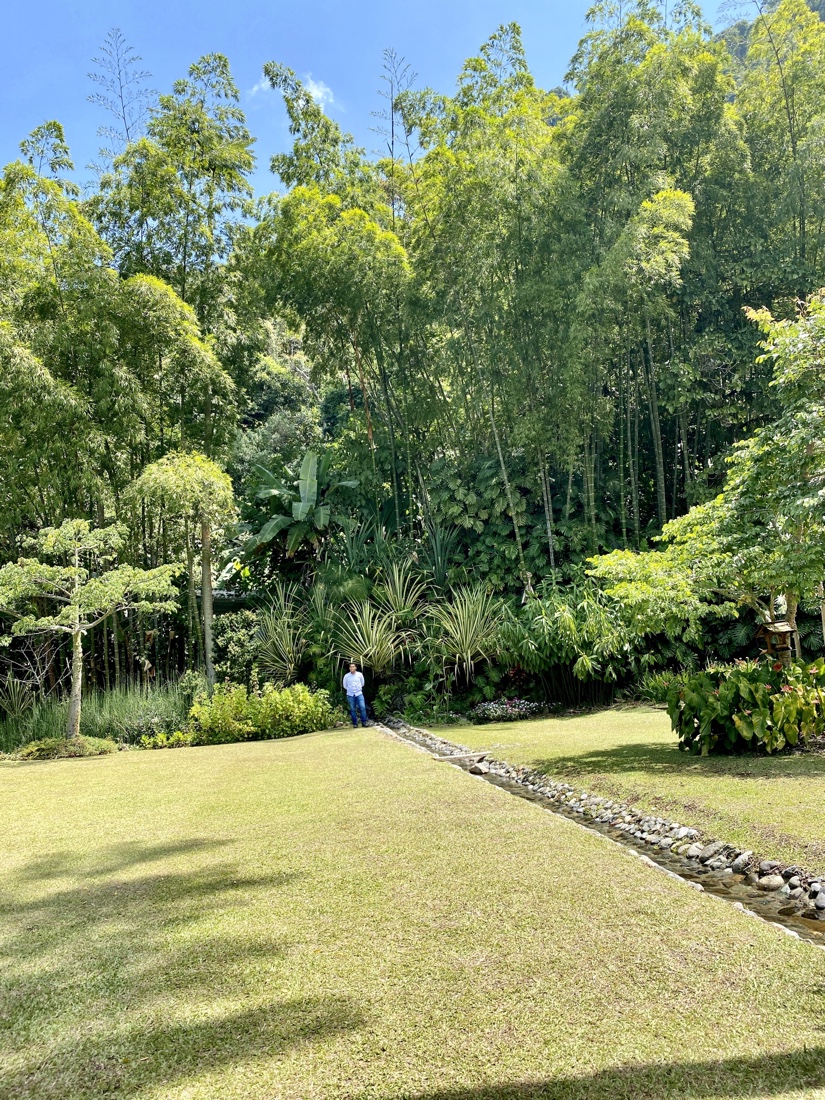 San Cayetano is Rainforest Alliance certified for their conscienscious treatment of the earth and UTZ fair trade certified for fair treatment of their employees. San Cayetano is Rainforest Alliance certified for their conscienscious treatment of the earth and UTZ fair trade certified for fair treatment of their employees.
Our personal tour highlights the best of Colombian cultivation on an expansive property that spans various elevations and cultivates both high-land and low-land coffee. We travel by jeep over an extremely bumpy road, driven by Felipe, vice president of San Cayetano, and accompanied by Brian. In the process, we are treated to breathtaking views of the central ridge of the Andes mountains and the Cauca River 3,000 feet below.
Along the route we encounter pickers who work on the farm, see how they live, and pass a school constructed on the farm specially for the children of families that work in the fields. Currently there are thirty pickers working, but in high season, October, there will be 250. Pickers are paid by the kilo. An average picker might pick 80 kilos in a day, but an expert may pick 250 or more kilos.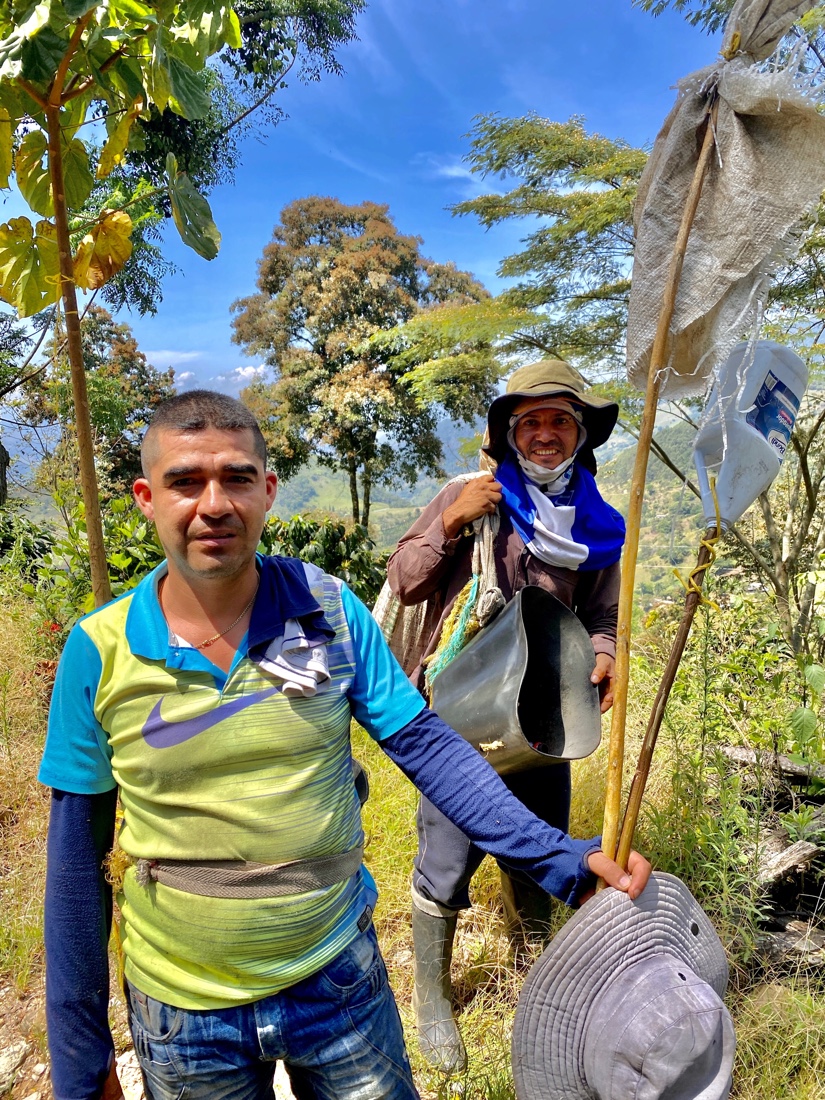 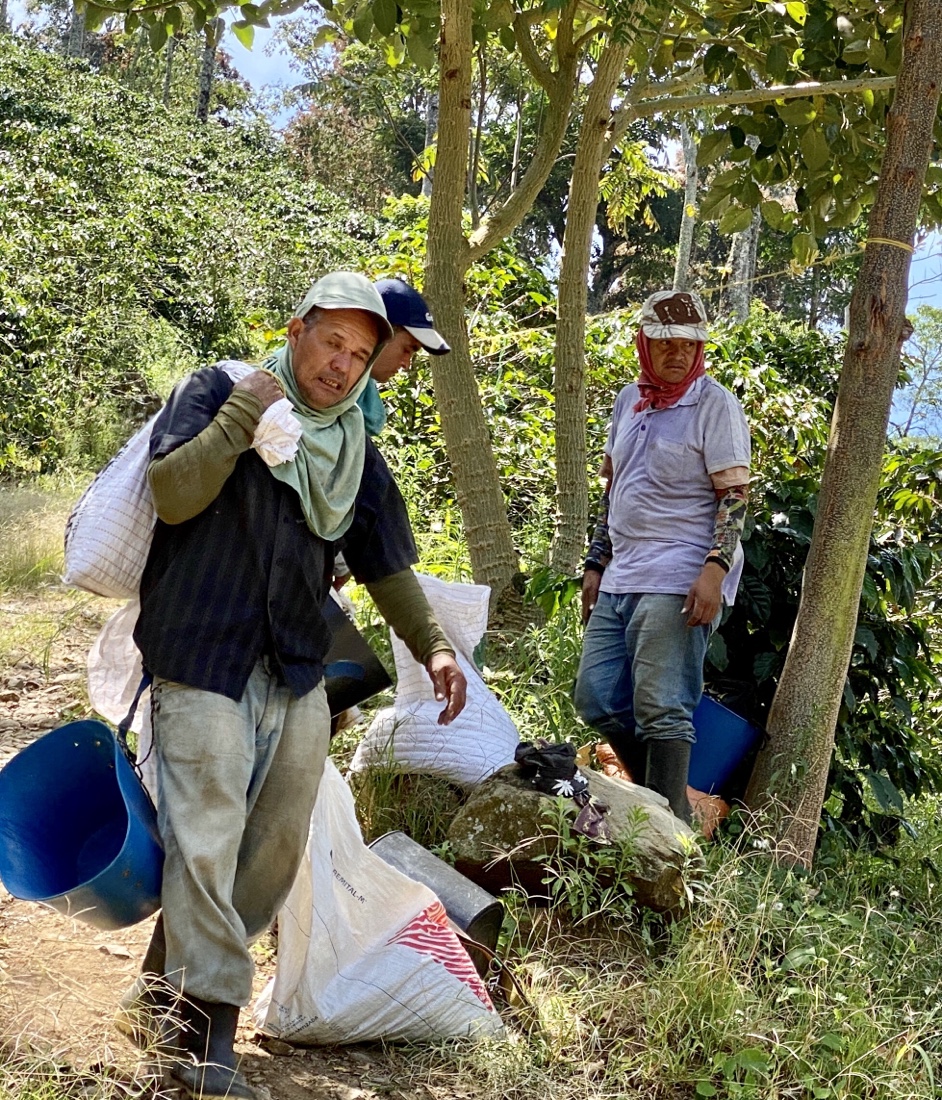 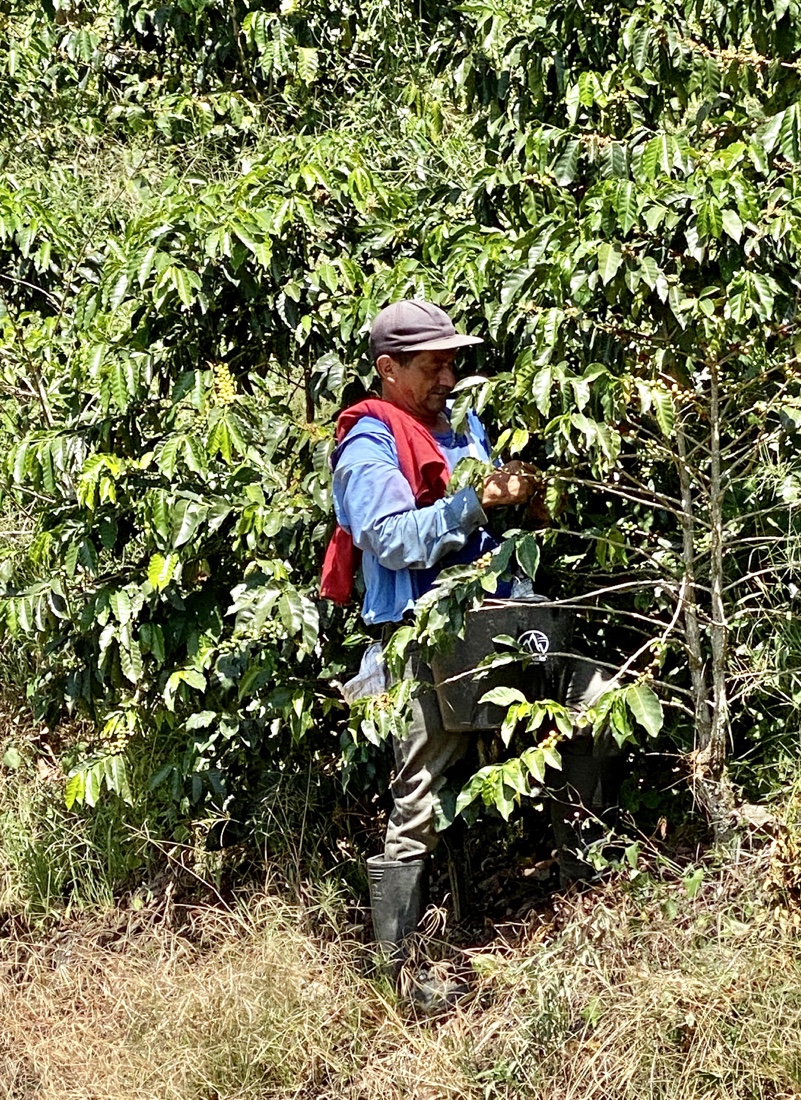 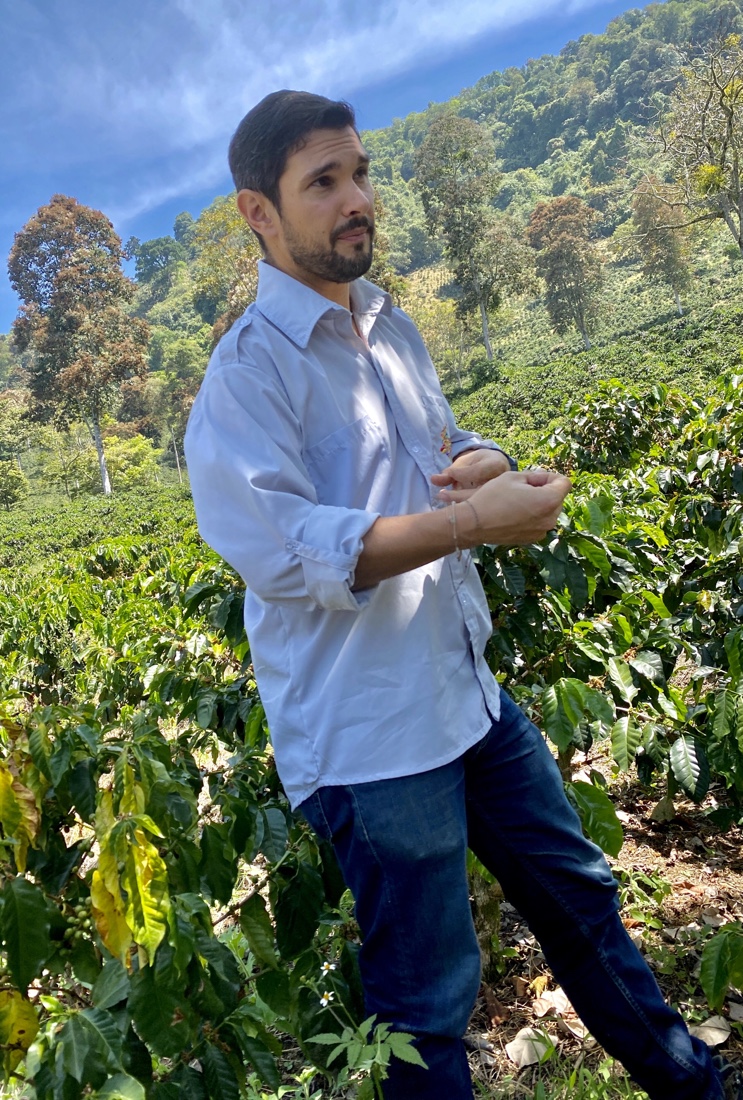
We are able to see every step of the lengthy and difficult coffee process from seed to cup, and see ripe beans straight from the tree. A vente at Starbucks will never quite be the same again. We stop for a traditional farm lunch back at the house.
After lunch, we visit the processing warehouse to see how they de-pulp, wash, and dry the beans in both traditional as well as specialty methods, promoted by a coffee initiative established by True Colombia Travel.
Back at the house, Brian prepares San Cayentano coffee for us using two different methods, and explains the reasons for each step of his preparation. If I was reading Carol’s body language correctly, she’s unlikely to be forsaking our coffee maker any time soon.
At the owner’s private mansion, we have the grounds to ourselves. We change into our swimsuits (after a nap, of course) and take a dip in the infinity pool. 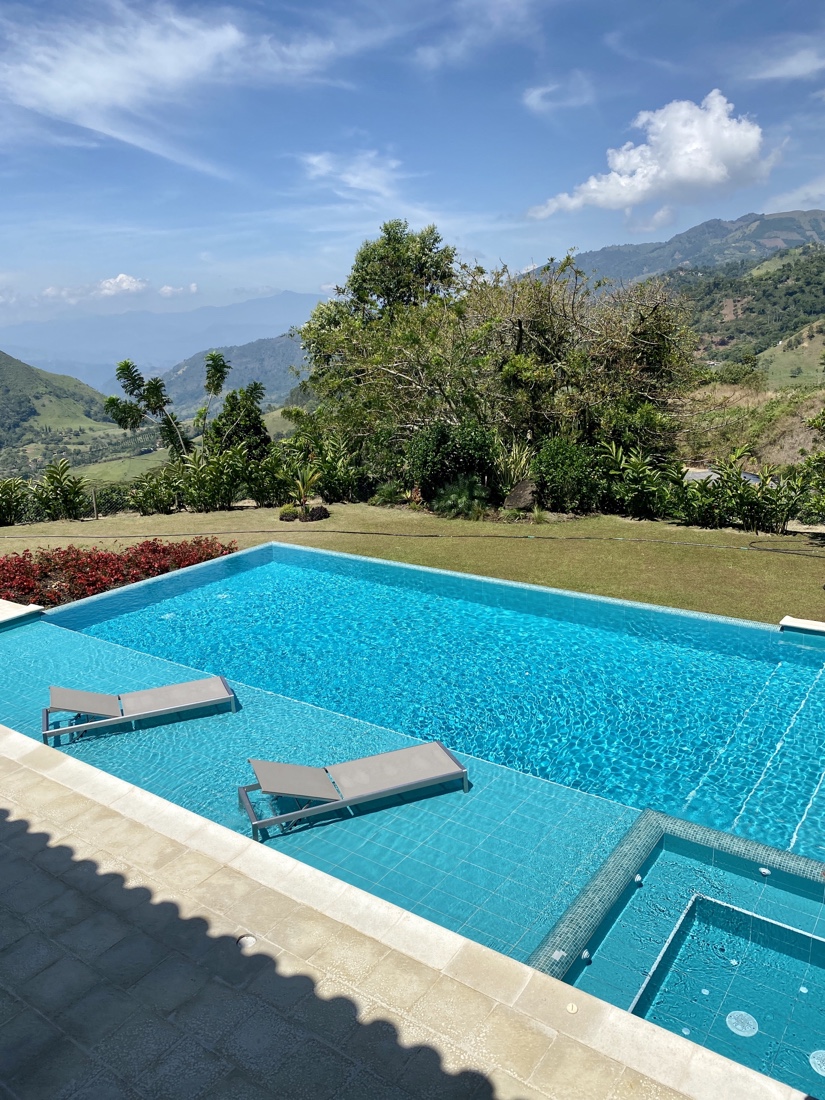 As the sun sets, we sit on the deck, reading and blogging. As the sun sets, we sit on the deck, reading and blogging. 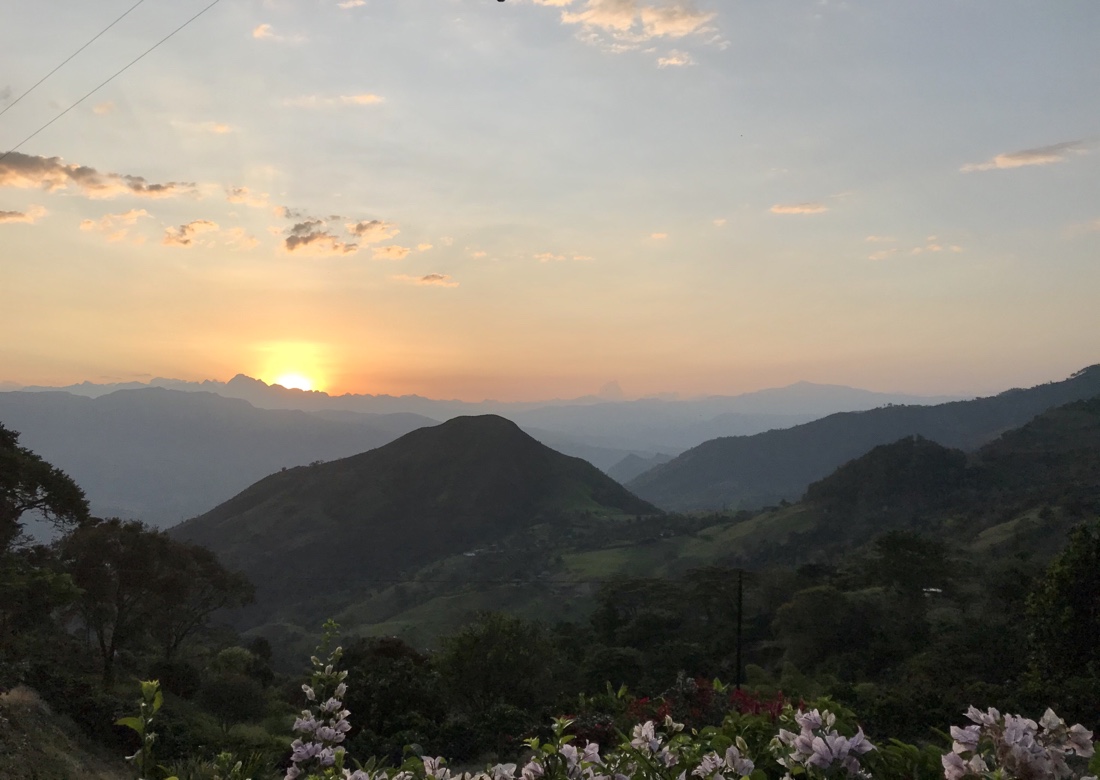
We’re served wine as the sun disappears from view. Later, we move over to the fire place, fed by coffee wood, and relax as we are served our dinner.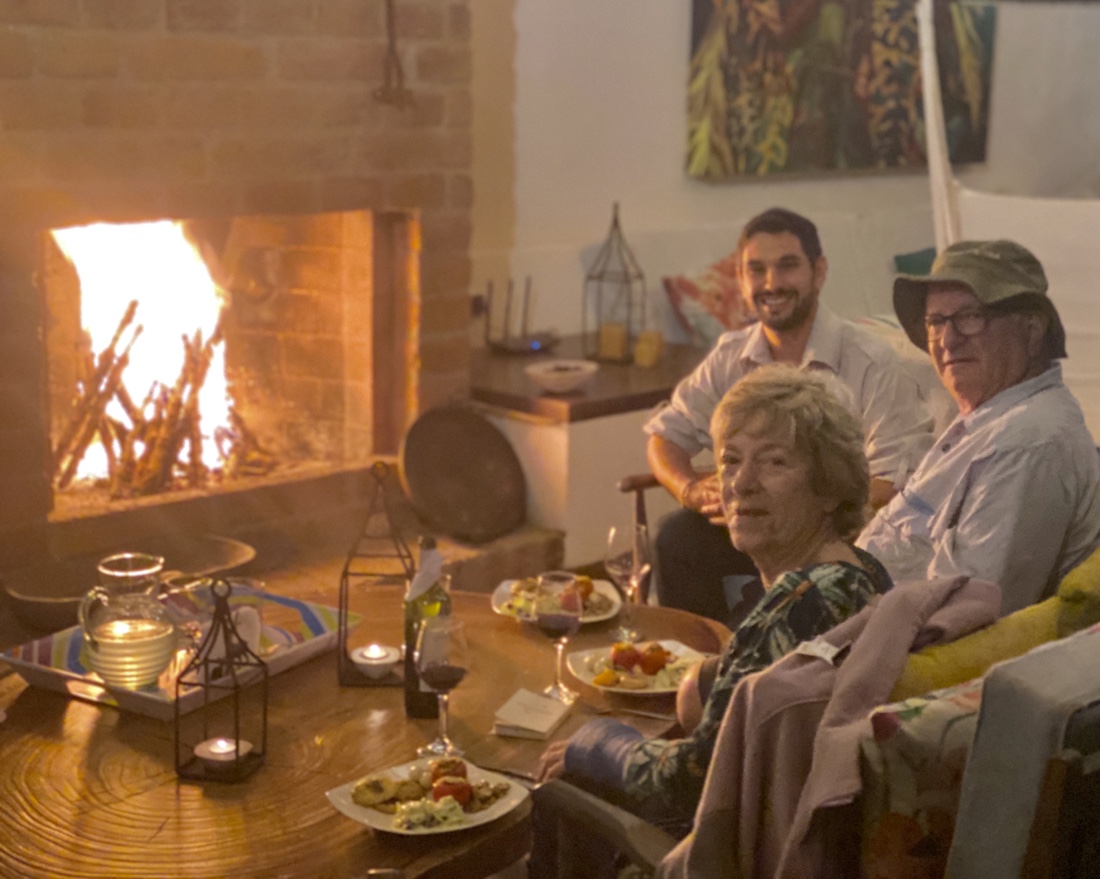
After dinner, I spend some time in the jacuzzi. Hey, somebody’s gotta do it, right?
A very interesting day. Not as much fun as the music school, but definitely worthwhile and, in the late afternoon and evening, very relaxing.
February 5.
Our stay at Cannua has been a terrific respite from city life. After breakfast, we are picked up from our hotel by Ana and driven an hour to Medellín, where we head over to the government center. We are happy to have Ana as our guide for the day, Brian getting a well-deserved one-day vacation from us.
We focus on the importance of architecture and transit in the city and the roles they’ve played in transforming Medellin into one of the most innovative cities in the world. We are told about the role of government and community in the change of the city and are shown locations that used to be among the most dangerous in the world but our now beacons of peace and civic pride in Medellín.
Here are a few street scenes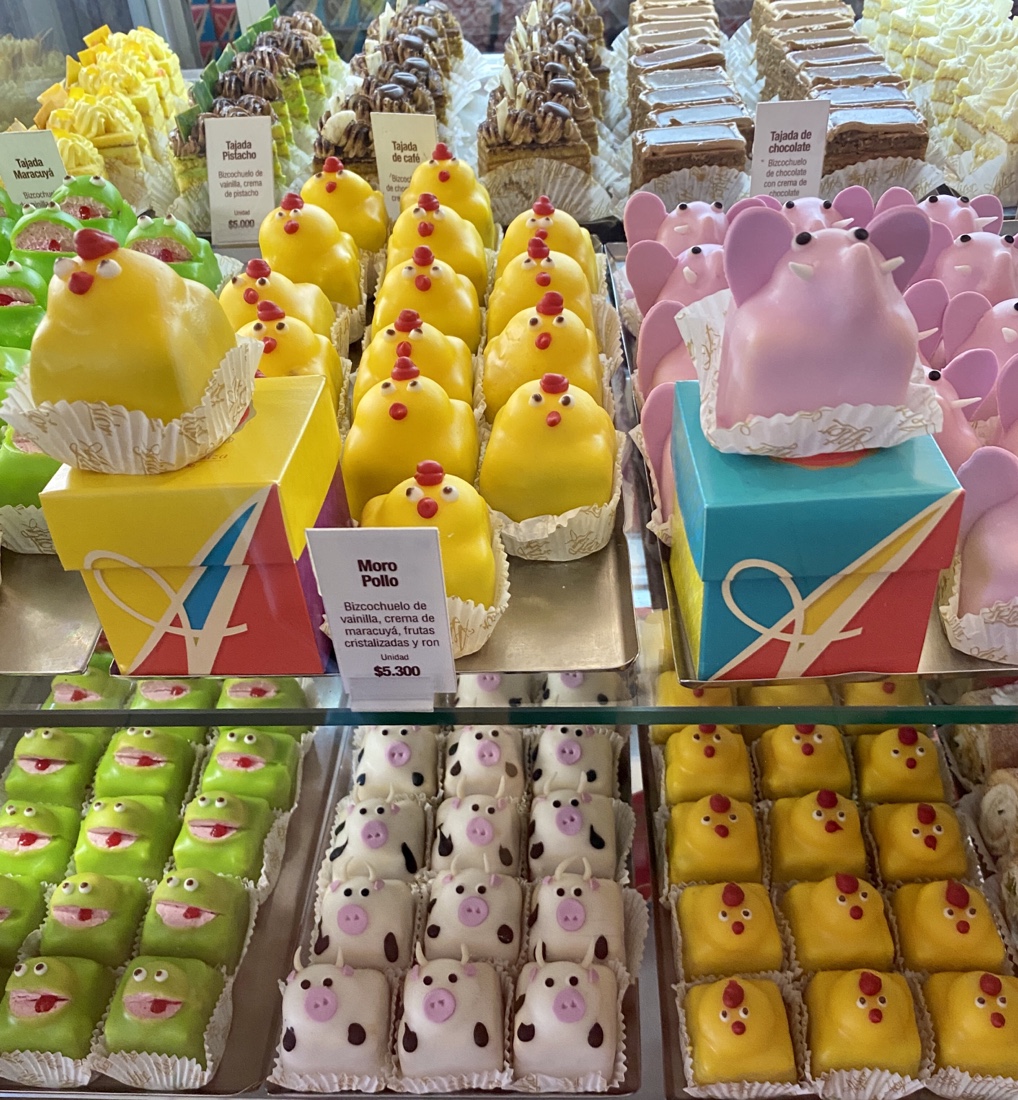
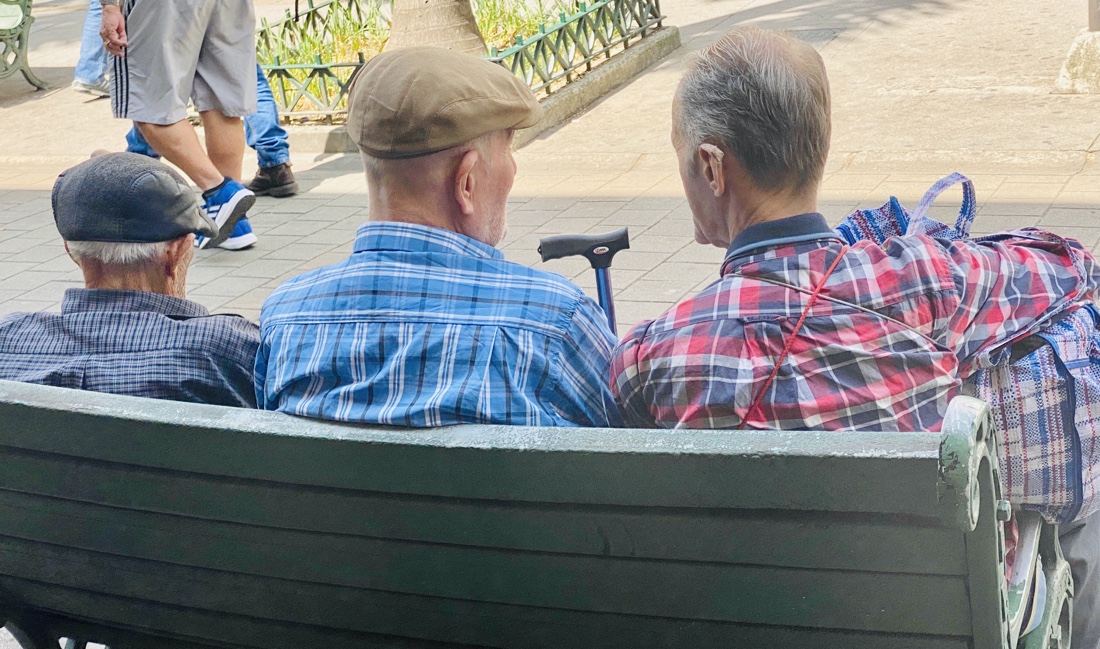 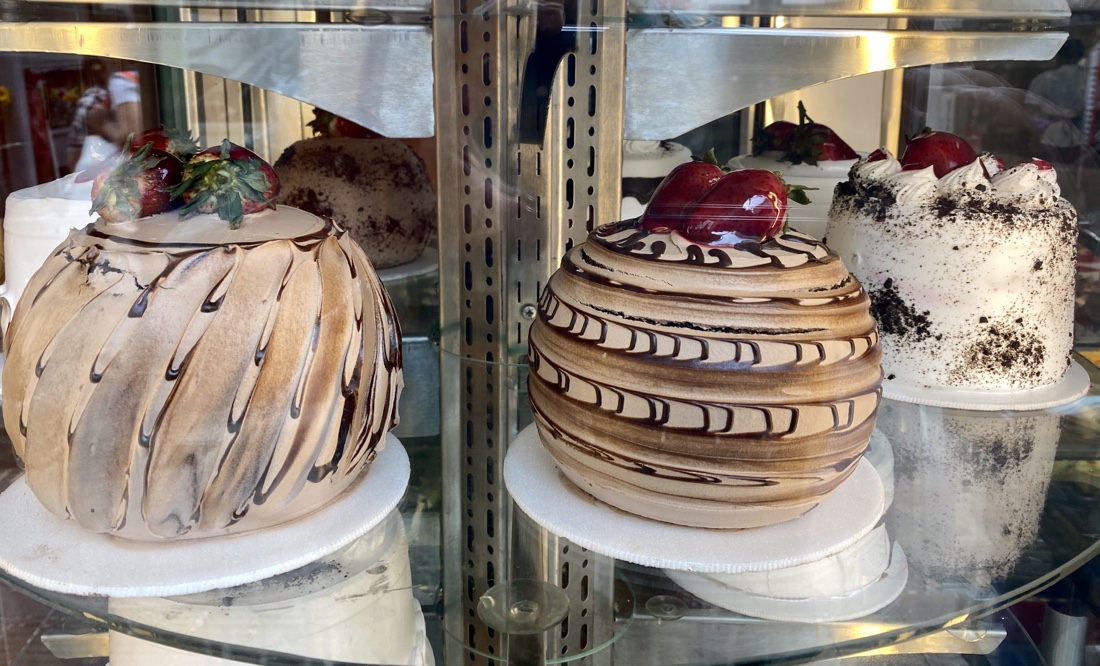 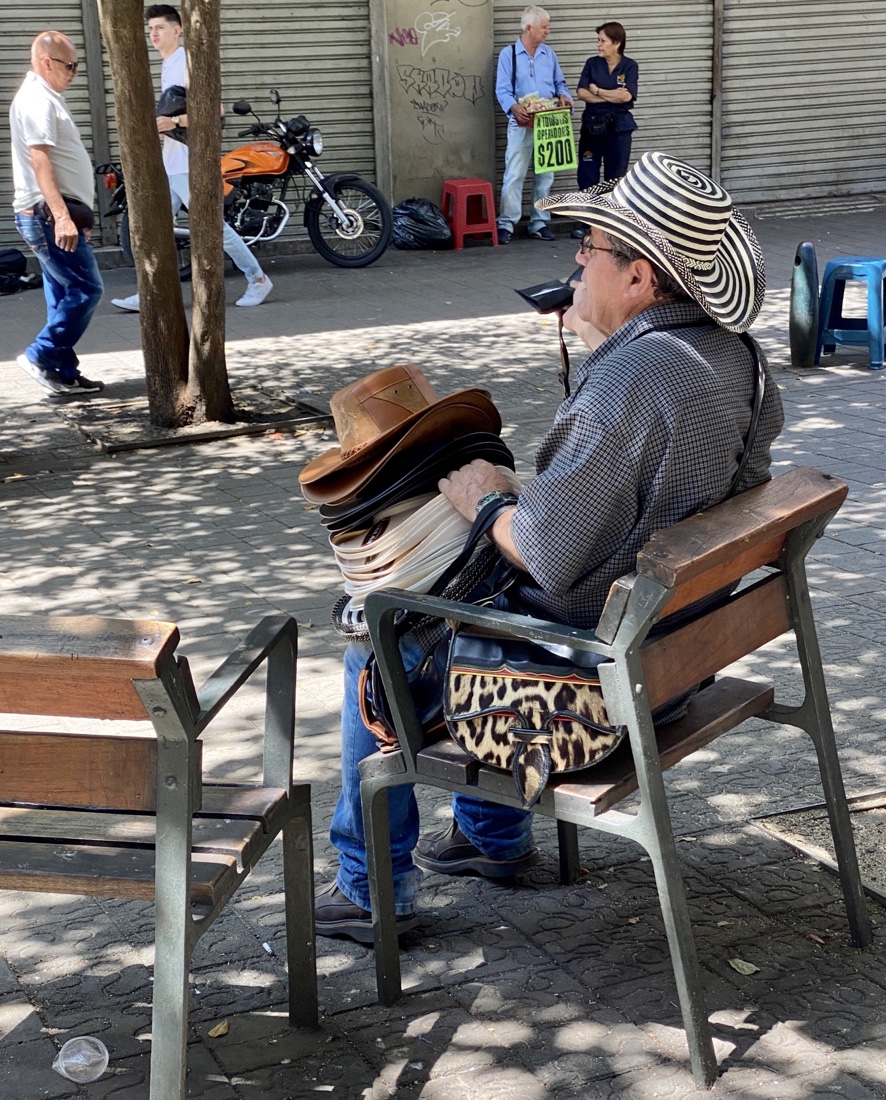 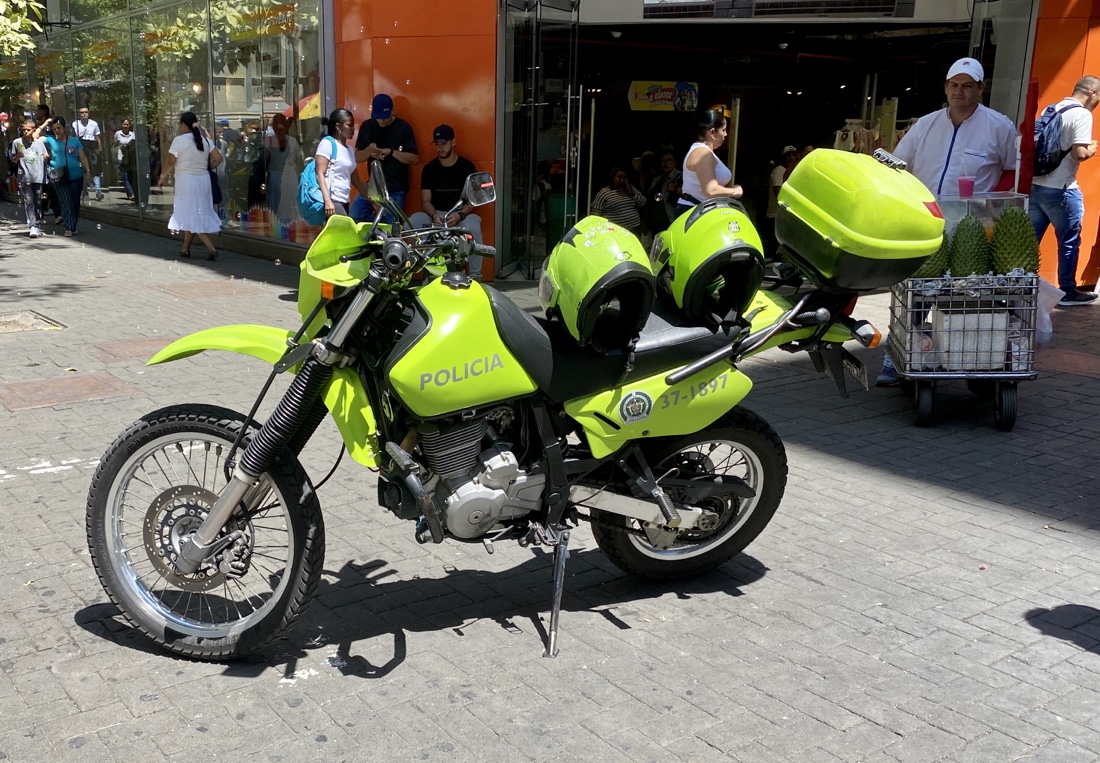 We stop for coffee with Ana at a place where people used to to come to tango and which is unchanged from the 1930s, old juke boxes and phonographs still in tact. We stop for coffee with Ana at a place where people used to to come to tango and which is unchanged from the 1930s, old juke boxes and phonographs still in tact.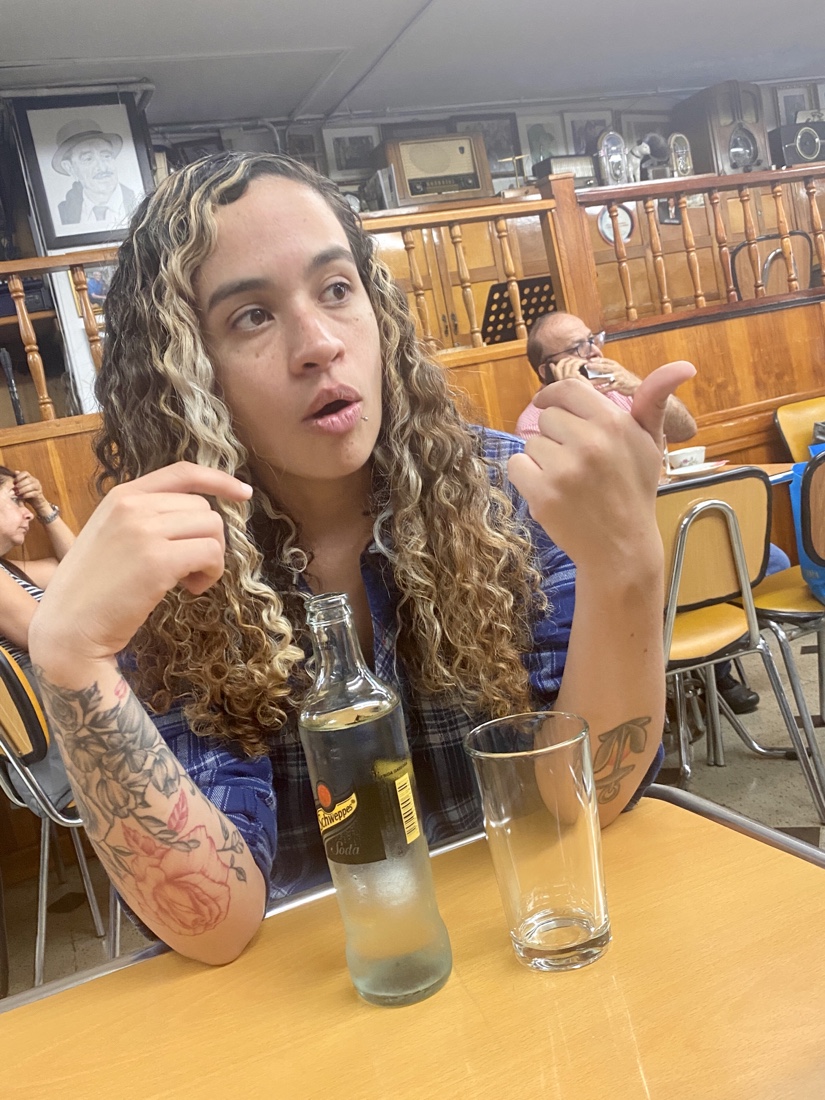
We head to Parque Berrio/Plaza Botero to explore both the world-famous sculptures of Fernando Botero in the plaza and walk through the Museum of Antioquia, full of sculptures, paintings, and drawings donated by Botero himself to his home city. Seeing so much of his work together certainly gives one a far greater appreciation for the scope and magnitude of his work.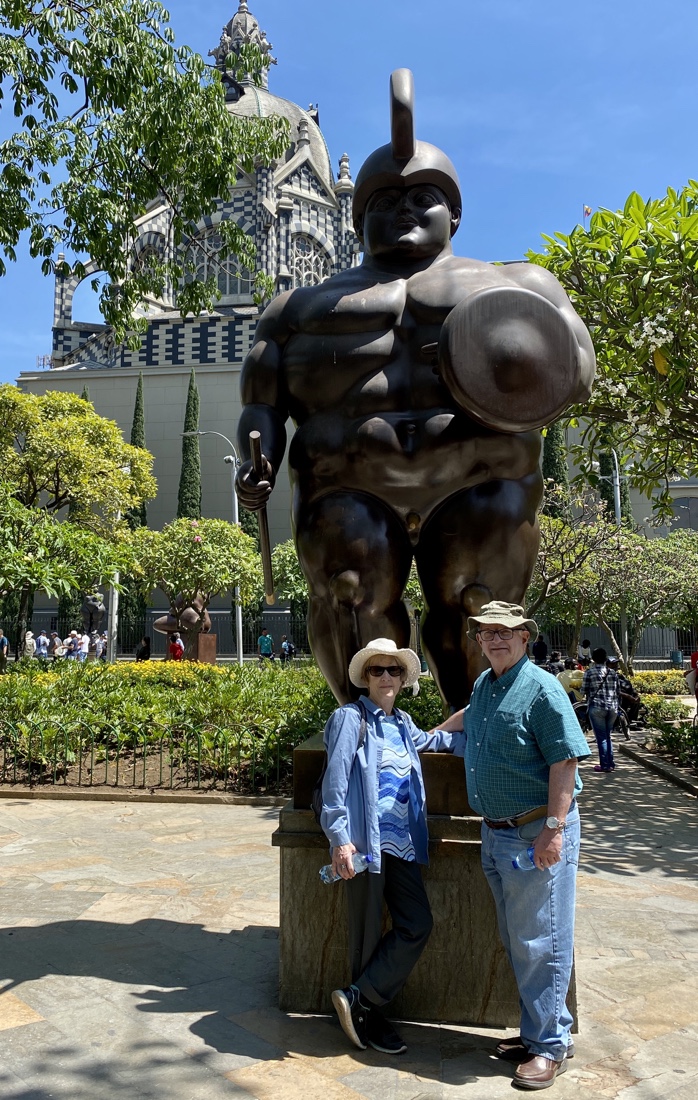 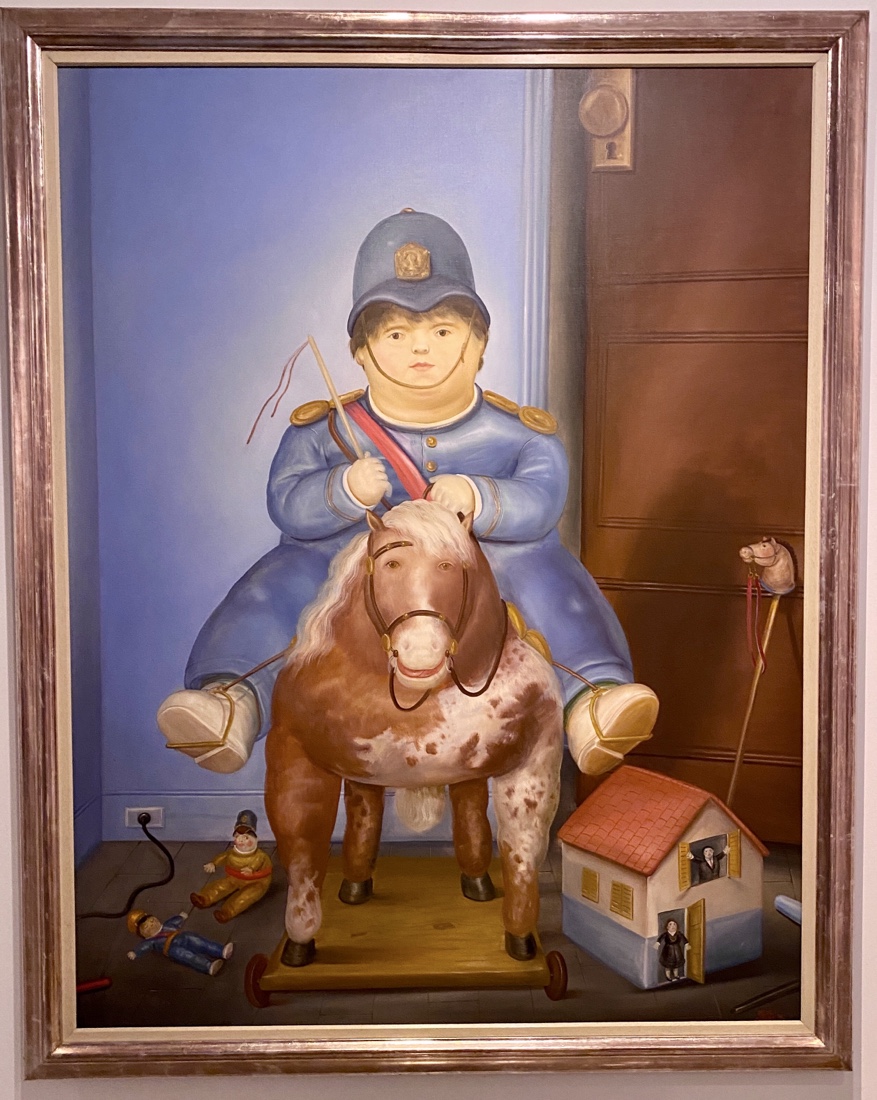 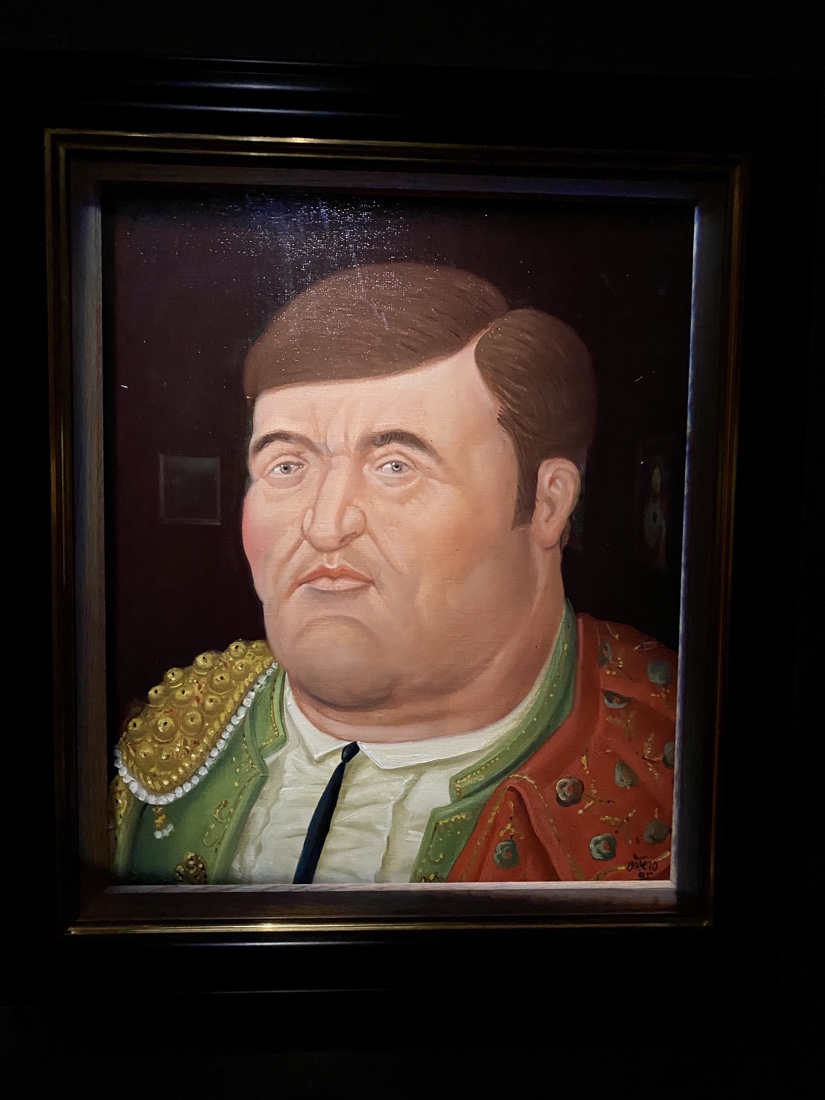
In the afternoon we have an exclusive and wonderful visit to one of the sites of the city’s music school network 1990s to teach classical music to children in the most dangerous parts of the city. The program was so successful that the children’s orchestra played a private concert for the Pope, and opened music halls across Europe. We learn about the network’s role in savings hundreds of lives in the city during the height of Medellín’s violence as we see children beginning their training.
We start with lunch together with students at the school. 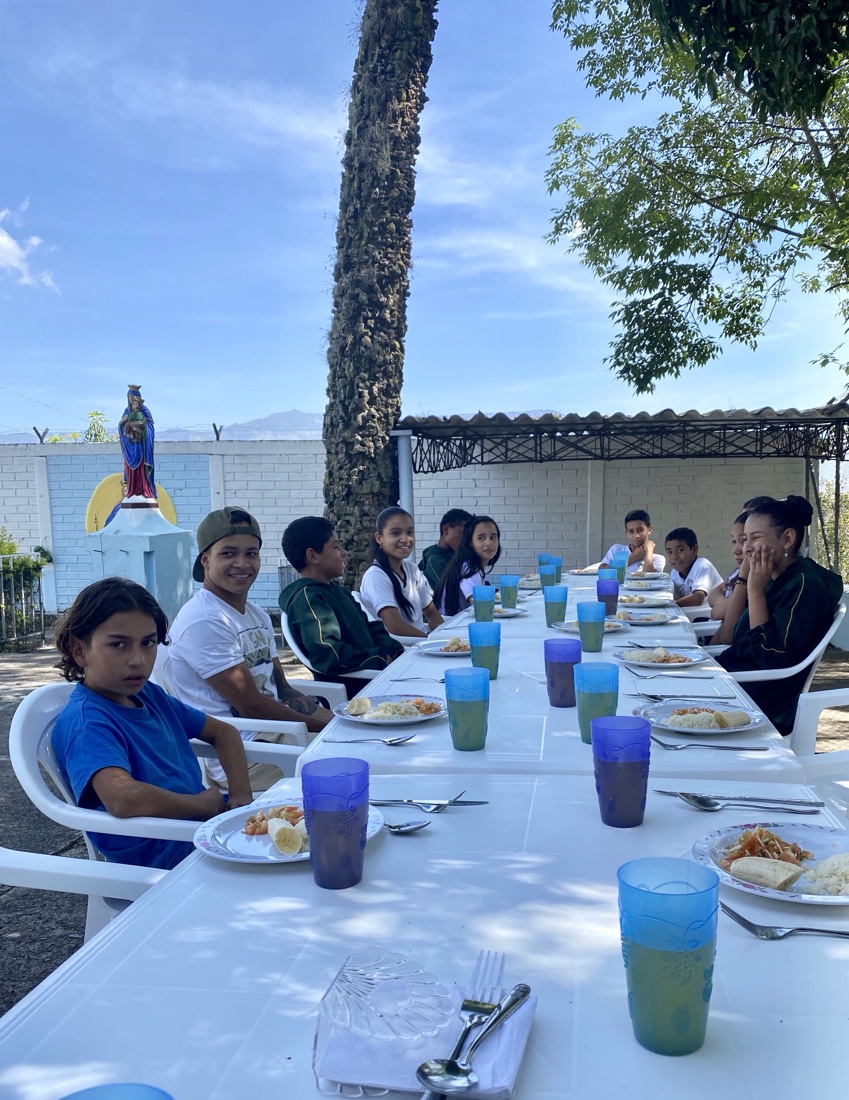 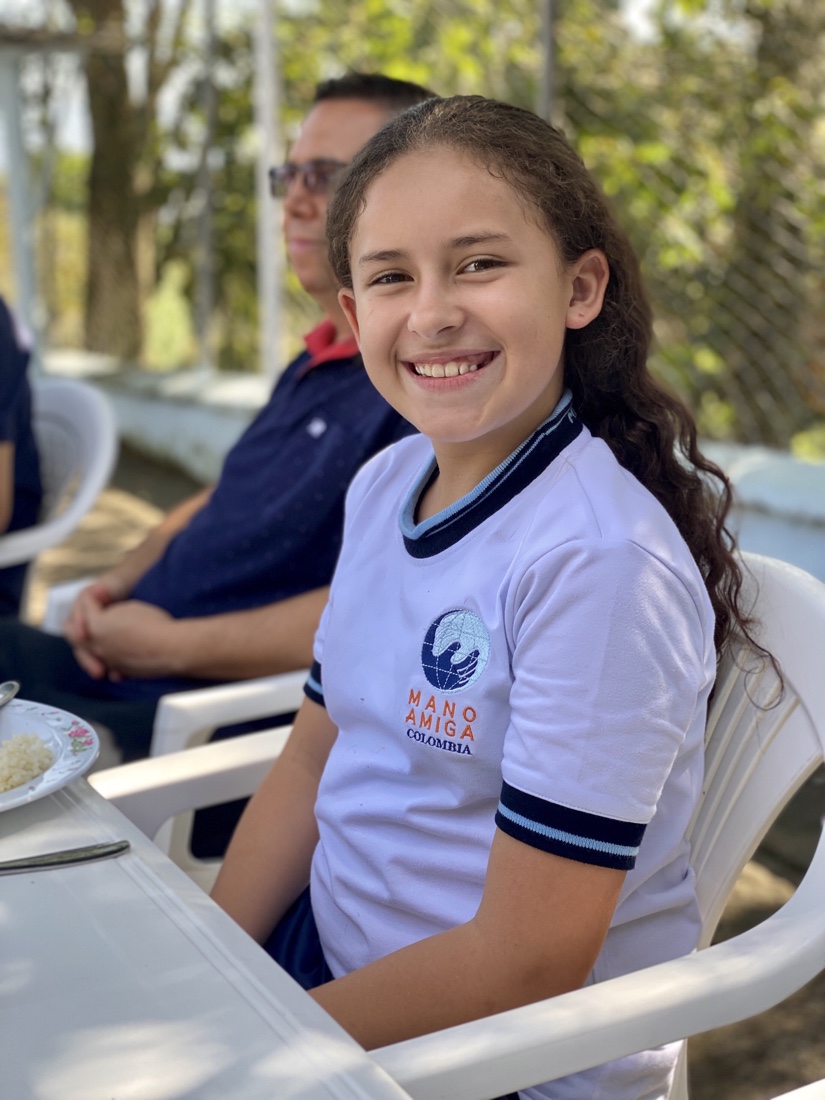 We are then told about the history of the creation of the school by Daniella, the daughter of the founder we will meet this evening, who works full time without pay for the Amadeus Foundation which supports the school. Daniella is totally delightful and passionate about the schools for work and articulate about its goals. We are then told about the history of the creation of the school by Daniella, the daughter of the founder we will meet this evening, who works full time without pay for the Amadeus Foundation which supports the school. Daniella is totally delightful and passionate about the schools for work and articulate about its goals. 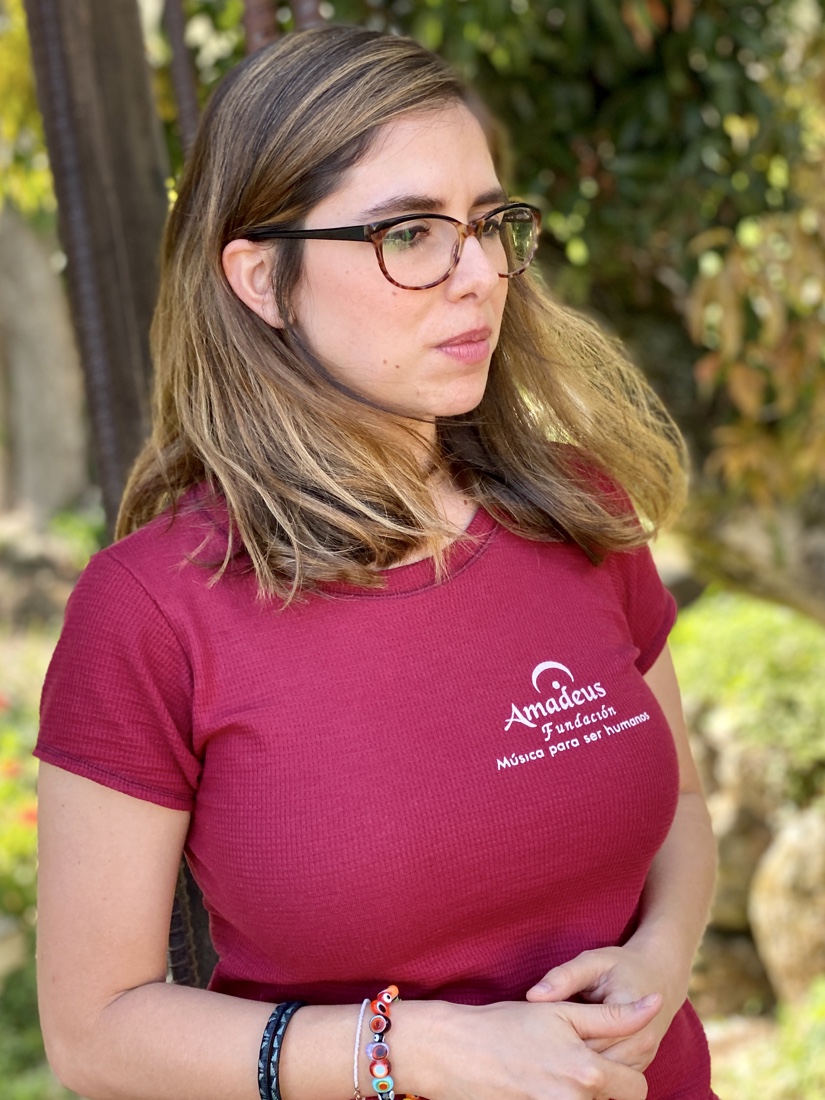 We tell her about FreshLens, the program that Carol and I have gotten involved in that teaches photography to under resourced children. There is a strong parallel between the music school and FreshLens, though the former requires a far greater commitment on the part of students. They come five days a week for five hours a day after attending regular school during the morning. We tell her about FreshLens, the program that Carol and I have gotten involved in that teaches photography to under resourced children. There is a strong parallel between the music school and FreshLens, though the former requires a far greater commitment on the part of students. They come five days a week for five hours a day after attending regular school during the morning.
We are treated to a concert of both choral and instrumental work by the students. The concert is great fun and the students seem extremely invested in what they are doing. Carol and I had a huge smile on her face during the entire time. I think it is likely that we will wind up supporting the school in some way.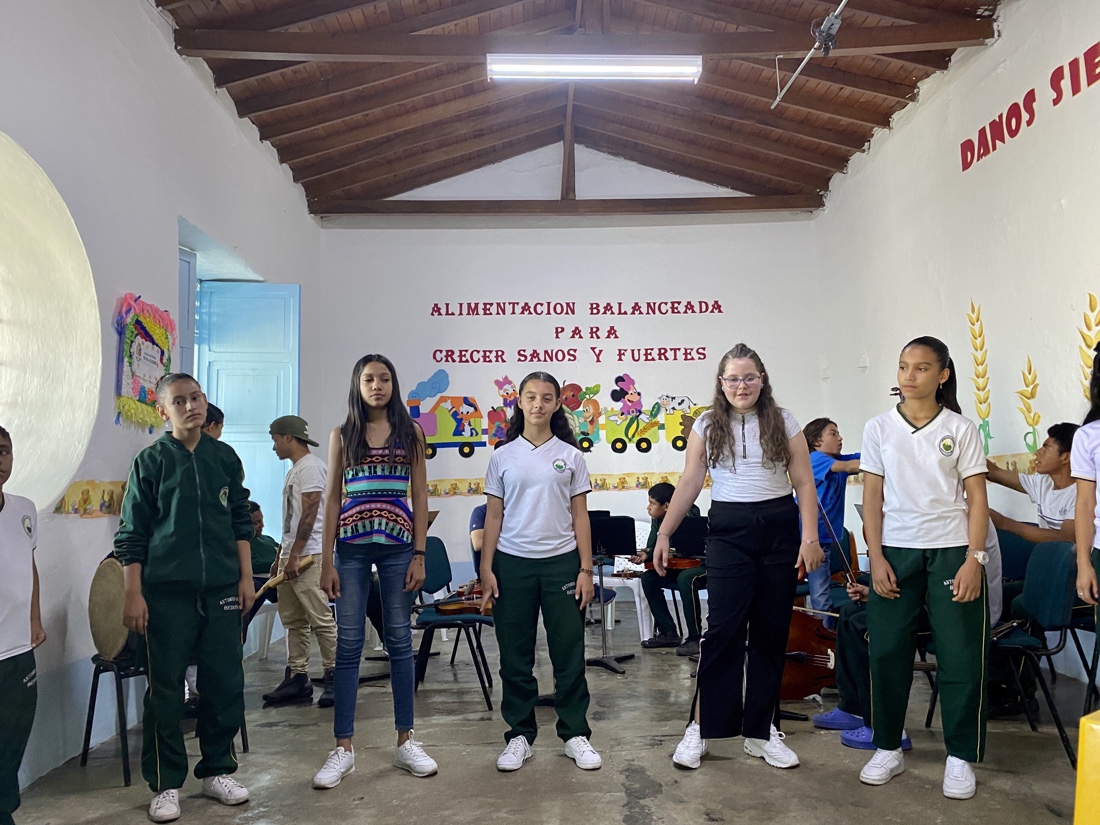 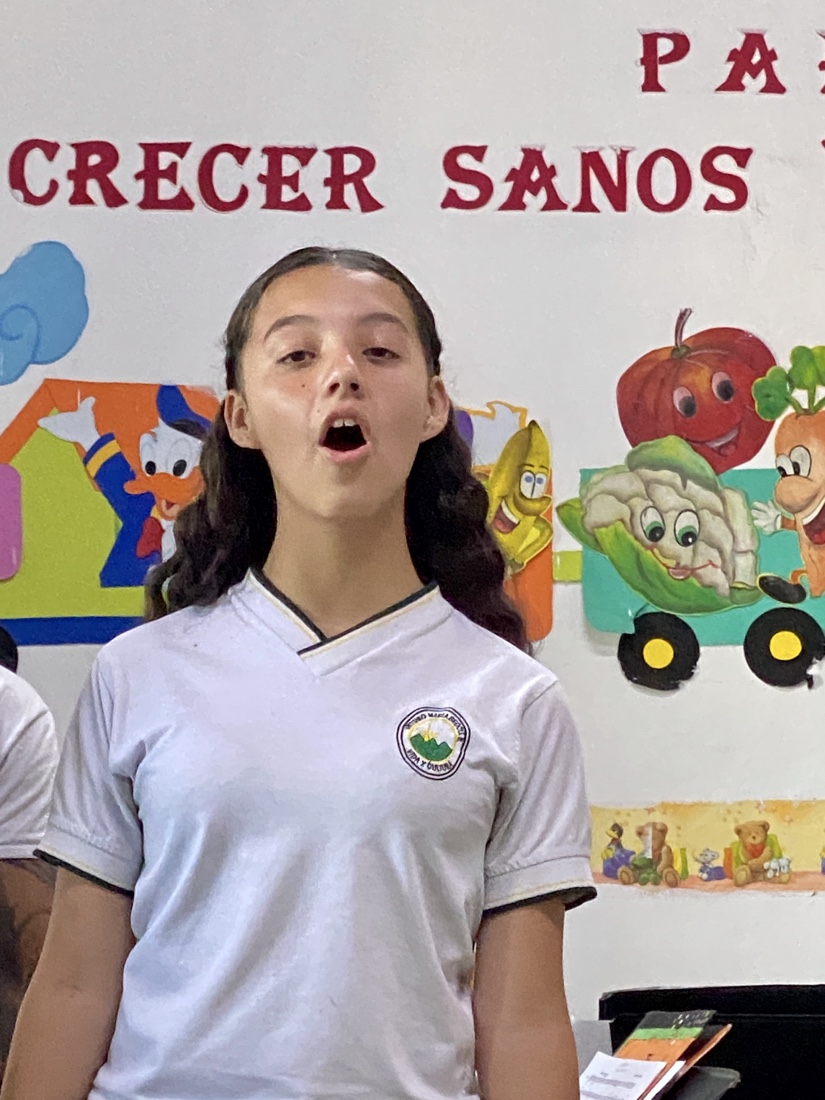 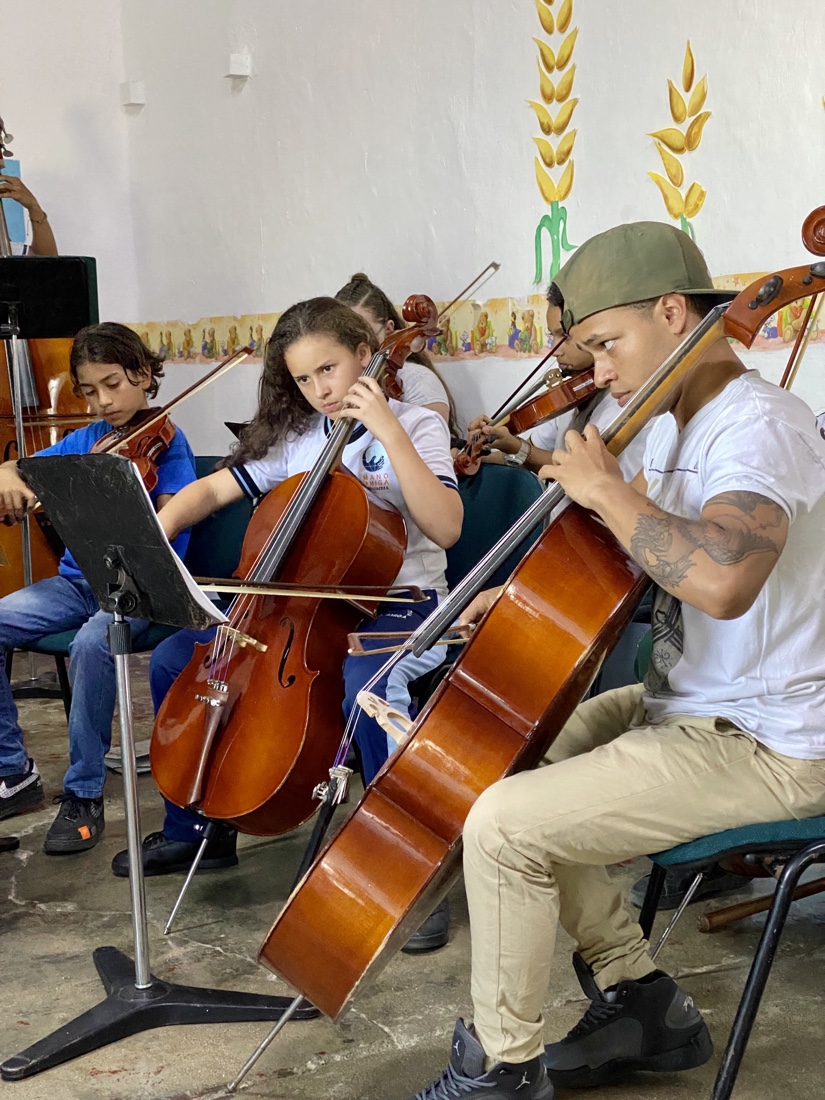 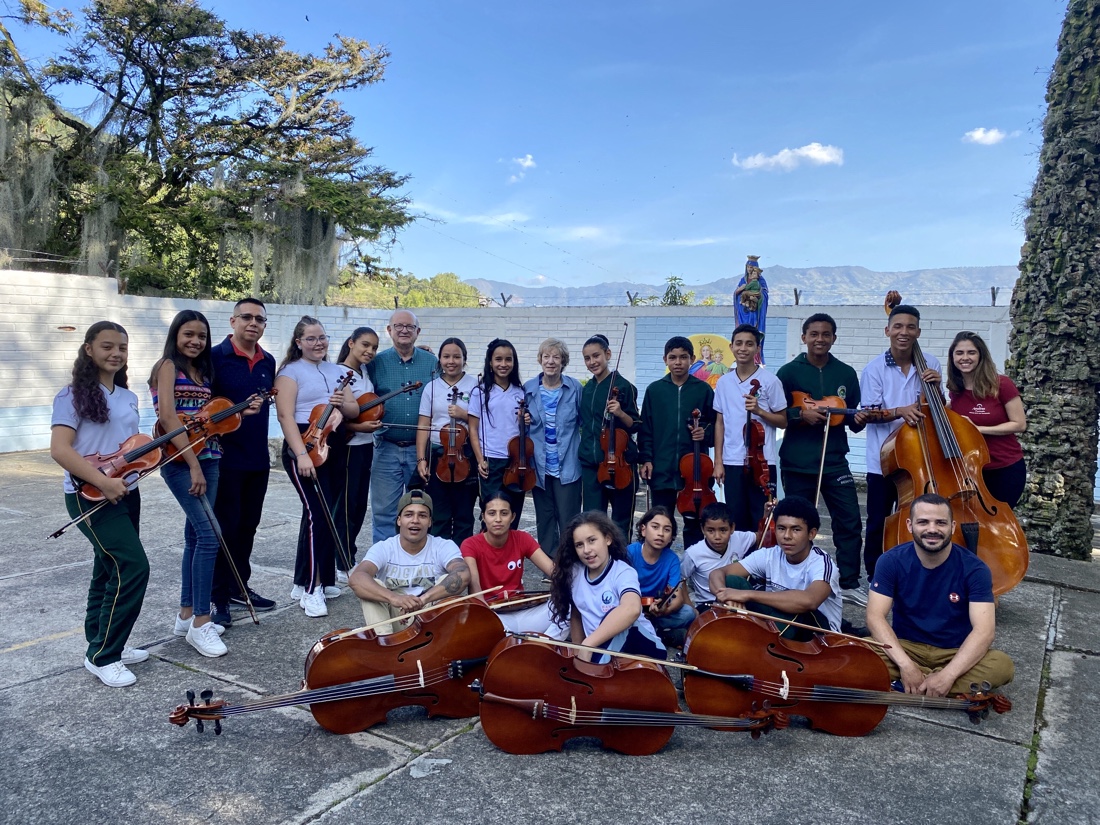
Afterwards we head to the Park 10 hotel and our two-story presidential suite to rest before the evening’s special event. We are driven by Ana to the city’s Botanic Gardens for which special admission has been arranged. We walk over to a private tent where we meet the visionary founder of the musical school network, Juan Guillermo, and listen to two now adult-musicians trained from the very first class of students in the 90s, Ana’s husband, Freddy, playing cello, and Estéban, playing violin. They are some of the finest musicians in Colombia and play a private collection of pieces just for us. Juan Guillermo is an amazing, warm and charismatic fellow. Talking with him about his vision and how he has made it happen, changing the lives of thousands of poor kids, is inspirational. A magical evening.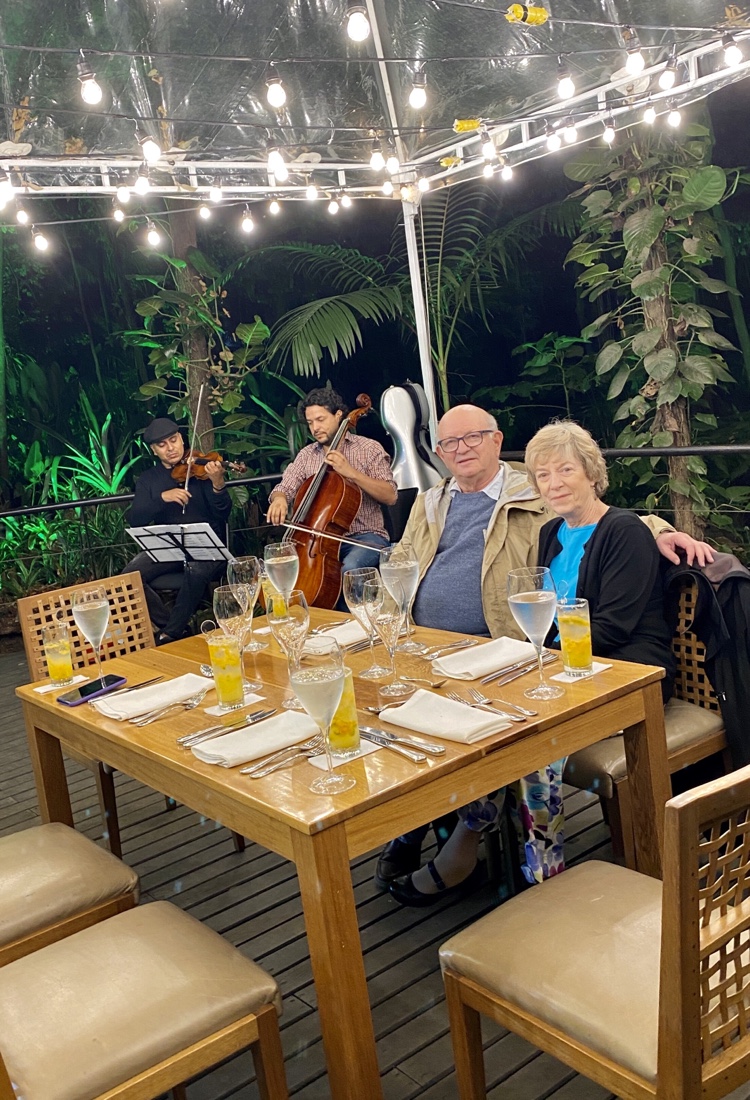 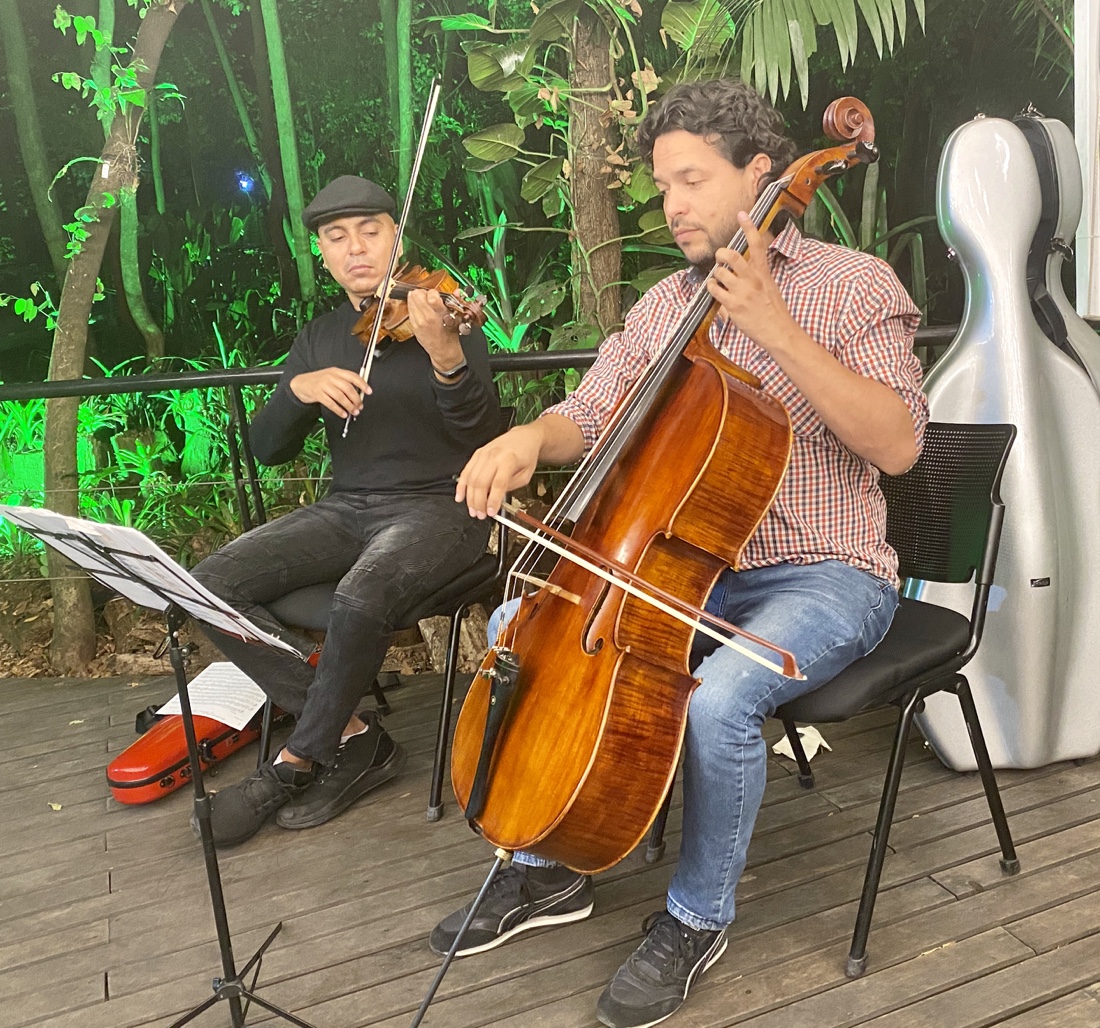 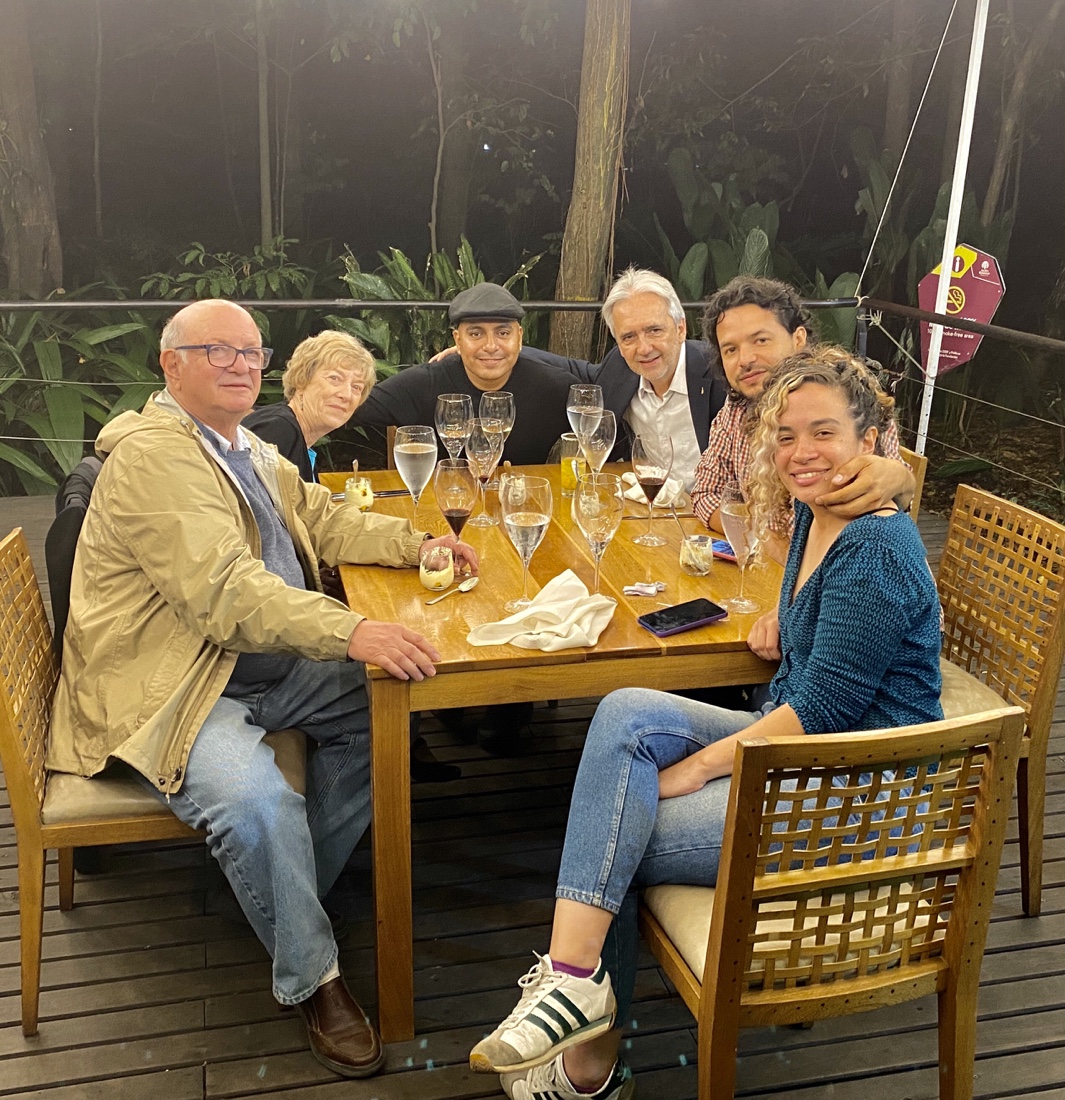
Afterwards, we return to our hotel, use the two free drink tickets we were given at check-in in the restaurant and go up to retire.
Botero and Medellin were interesting enough, but did not compare to the rest of our day and evening.
February 4.
Very good breakfast with a great view at the lodge.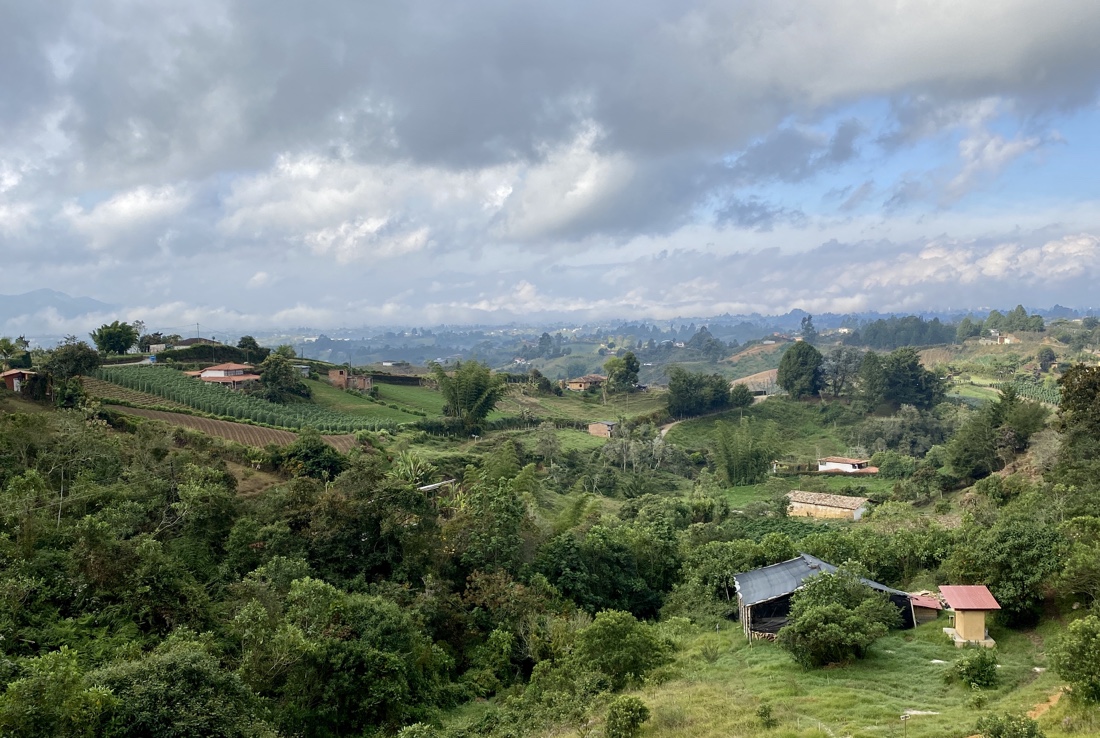
Ana, one of Brian’s business partners joins us and we hop in the car to head to the town of El Carmen. Carmen is famous across Colombia for its tradition of producing high-quality, handmade and hand-painted ceramic wear. The tradition has been passed down for generations. We head to a small factory called Gratitud Artesanal, run by a master ceramicist named Bernardo. We meet him and then are guided through the entire process by a lovely young woman named Elisabeth Gallegos Quintero, who is a talented painter and now a ceramicist. Not only do we see the entire process, though, we participate in each step of the process, which is great fun, and makes the several hours we spend there fly by. Brian and Ana are both very familiar with the process, and comment as we go along.
Elizabeth shows us photos of several plates she designed for a client. Carol and I love them and commission Elizabeth to design some plates for us. 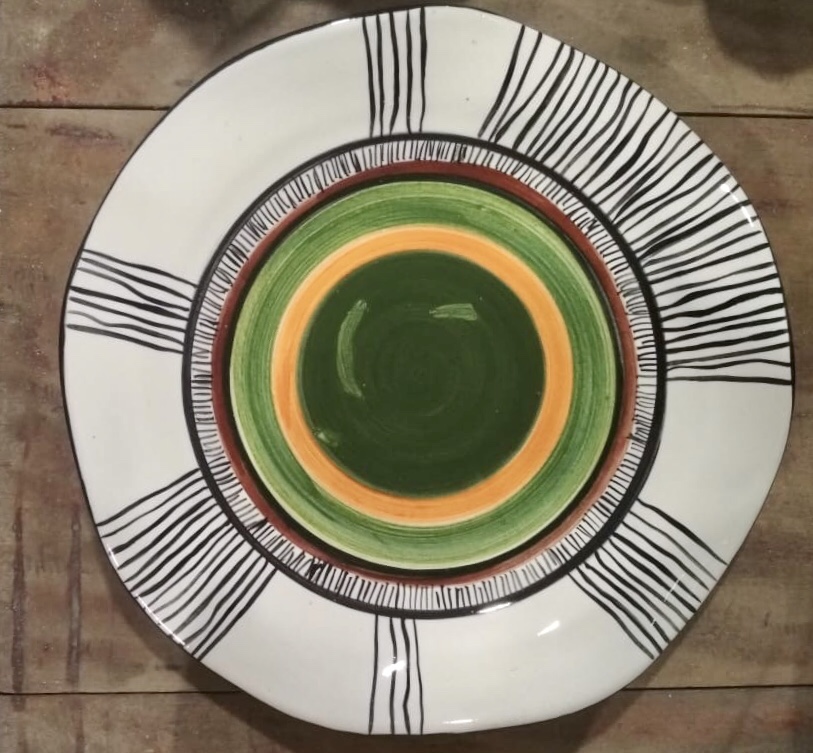 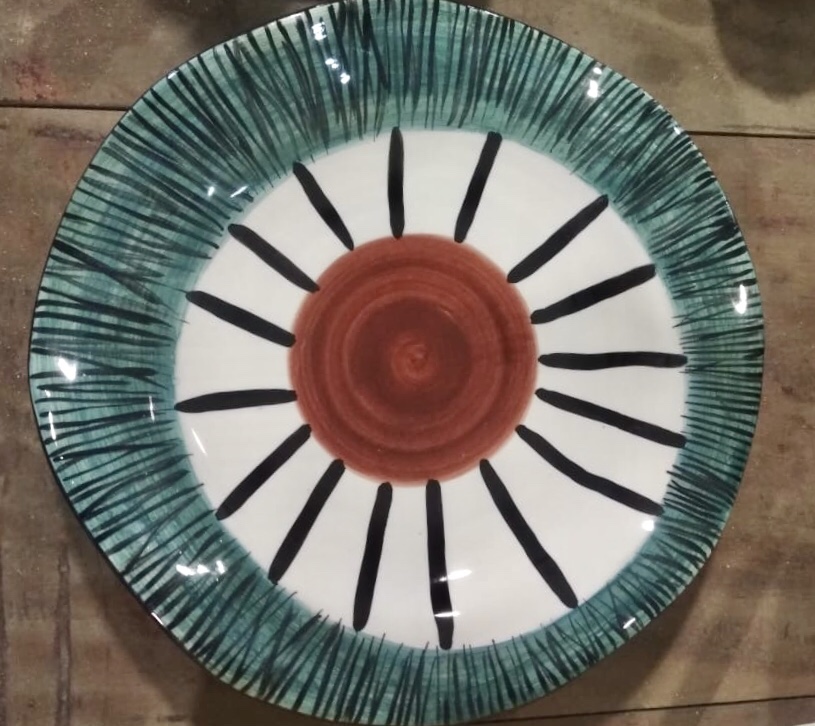
From the ceramics factory, we drive to lunch at Con Tradicion, where we are served gourmet Colombian food from an internationally traveled chef, right in Marinilla. Brian and Ana are absolutely delightful companions. Ana is a trained veterinarian and plans activities for guests at the lodge.
After lunch, we drive to Marinilla, a typical Antioquian pueblo not yet discovered by tourists. Marinilla is known as the “Sparta of Colombia” for the enthusiasm and valor of soldiers from the area during the war for independence from Spain. We walk through the town a bit with Ana. I get to take a few photos of some of my favorite subjects, doors, windows and walls.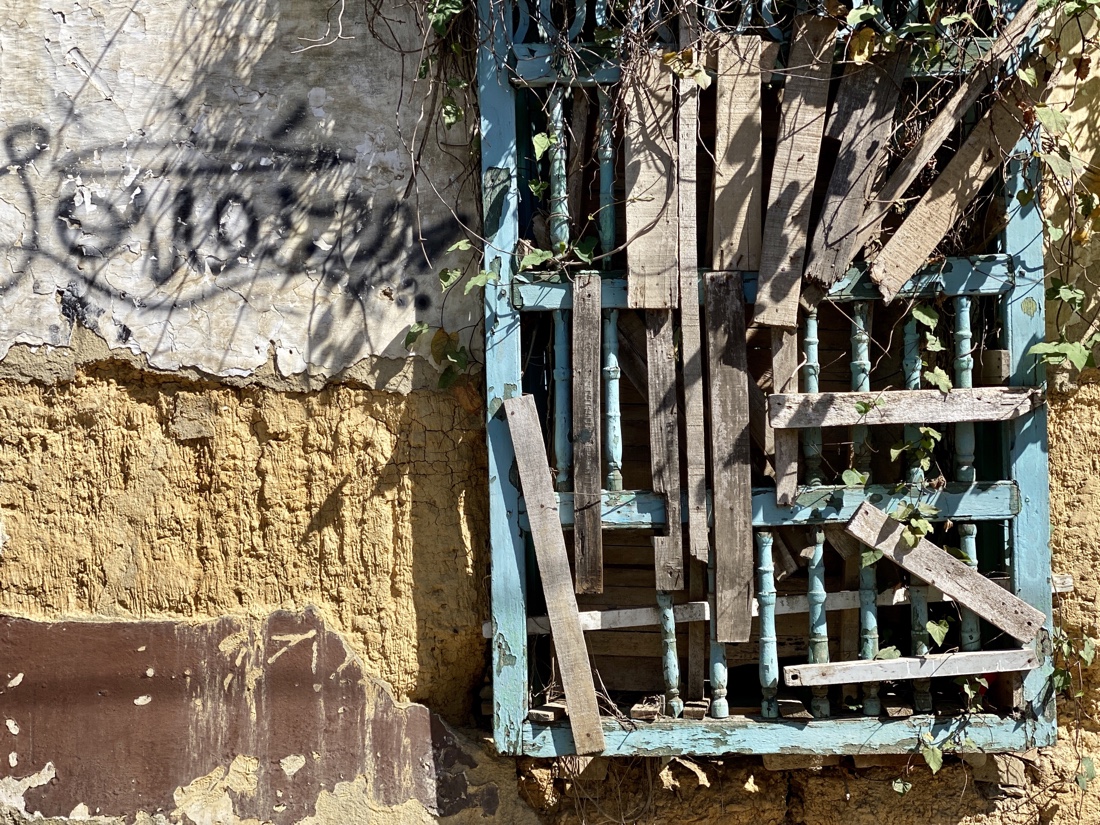 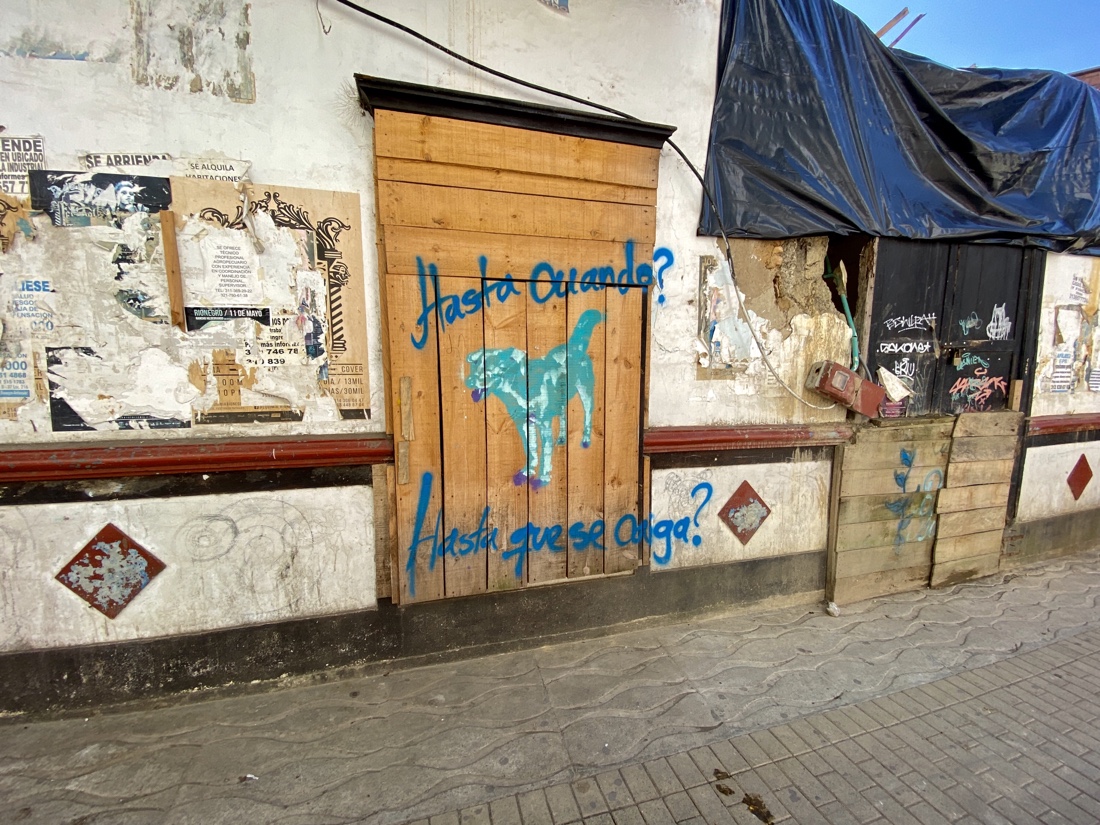 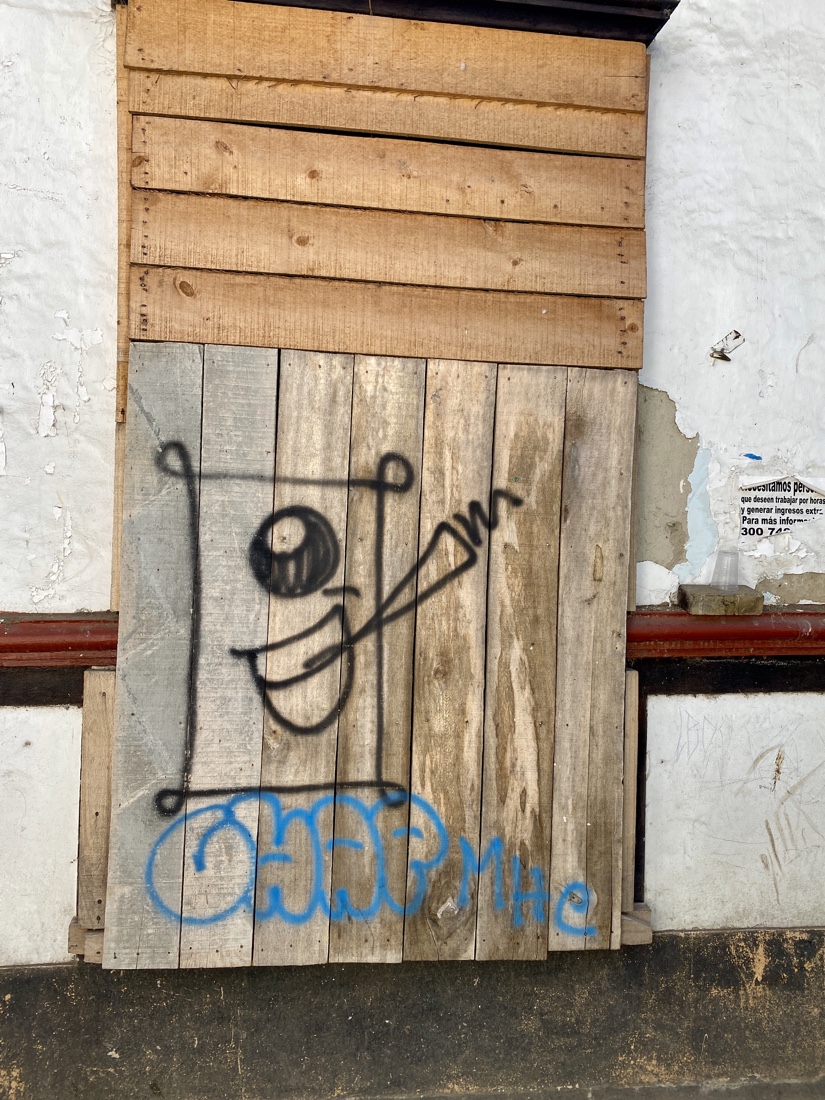
Marinilla is also home to one of Colombia’s most famous and best guitar factories. We are given exclusive access to the factory to learn about the production of guitars, and the story of the family that after decades, still runs the factory. We spend only about half an hour there, but it is worthwhile.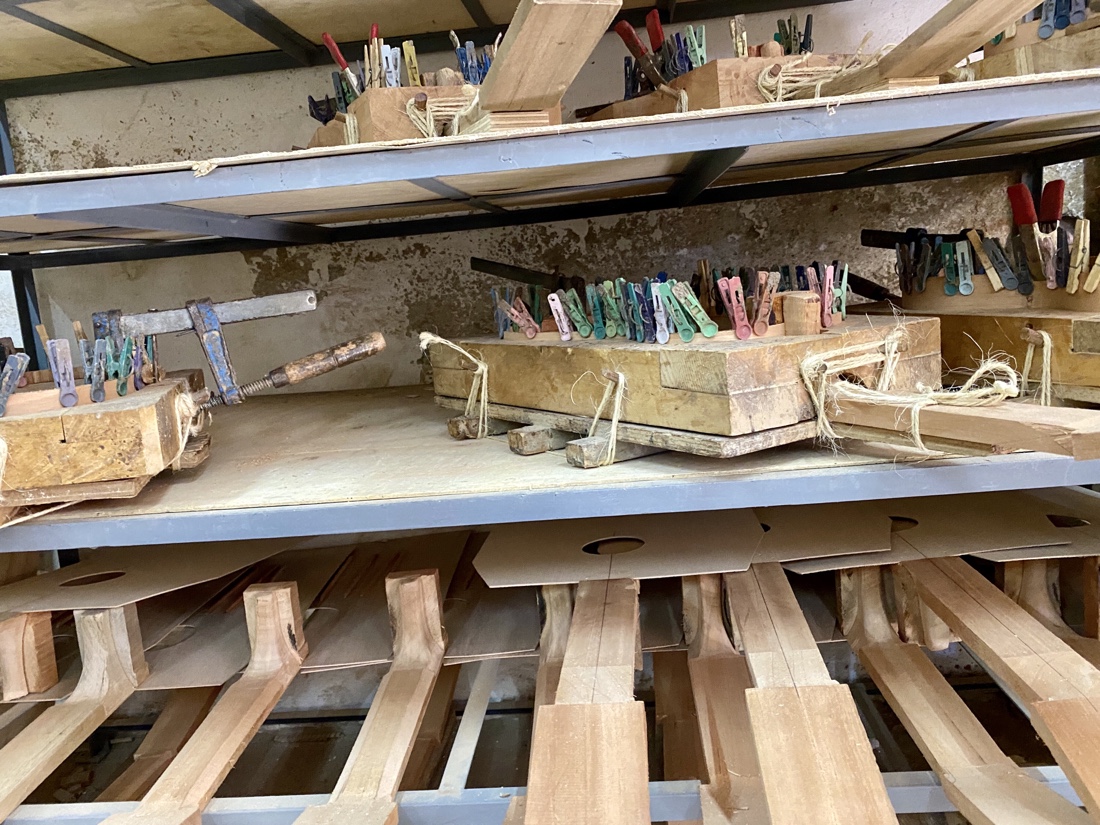 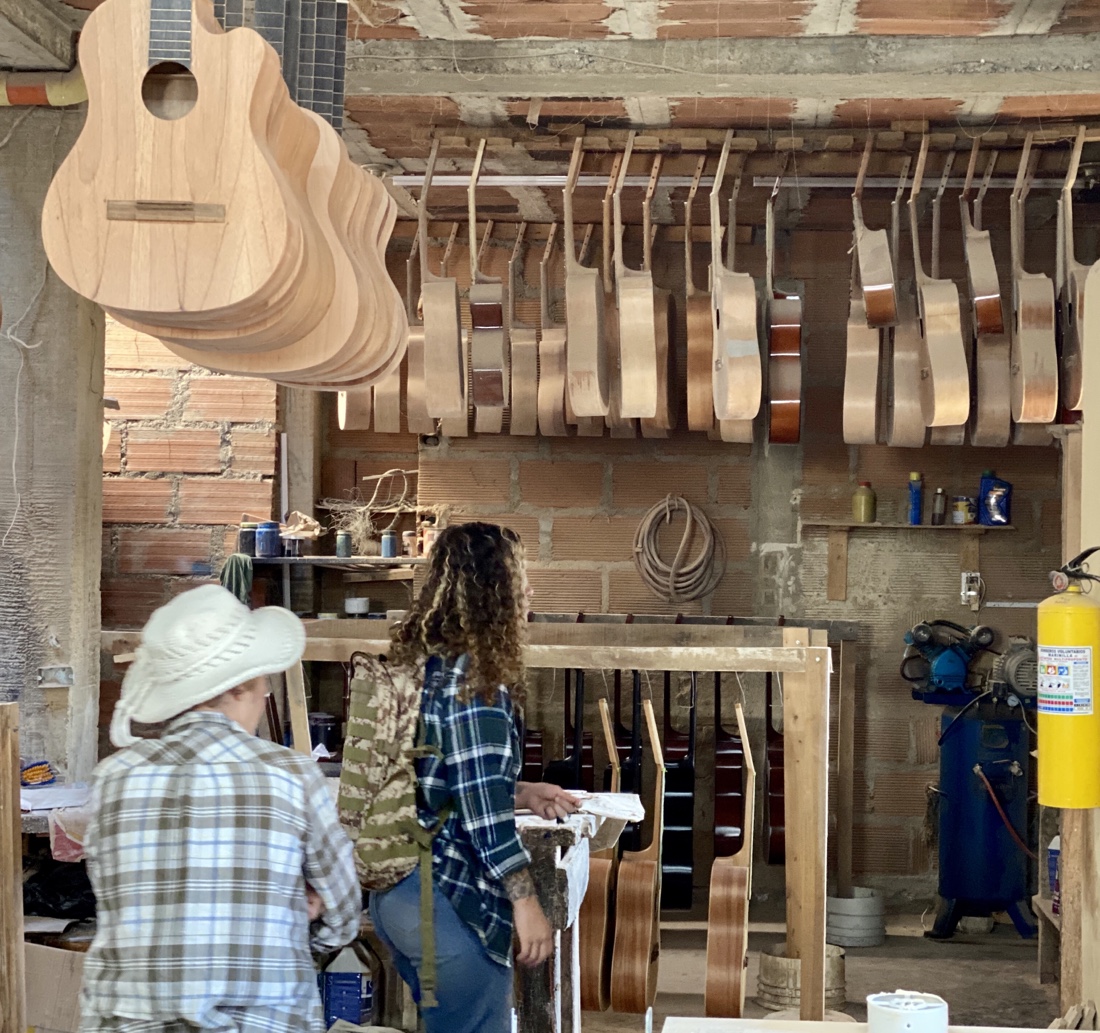 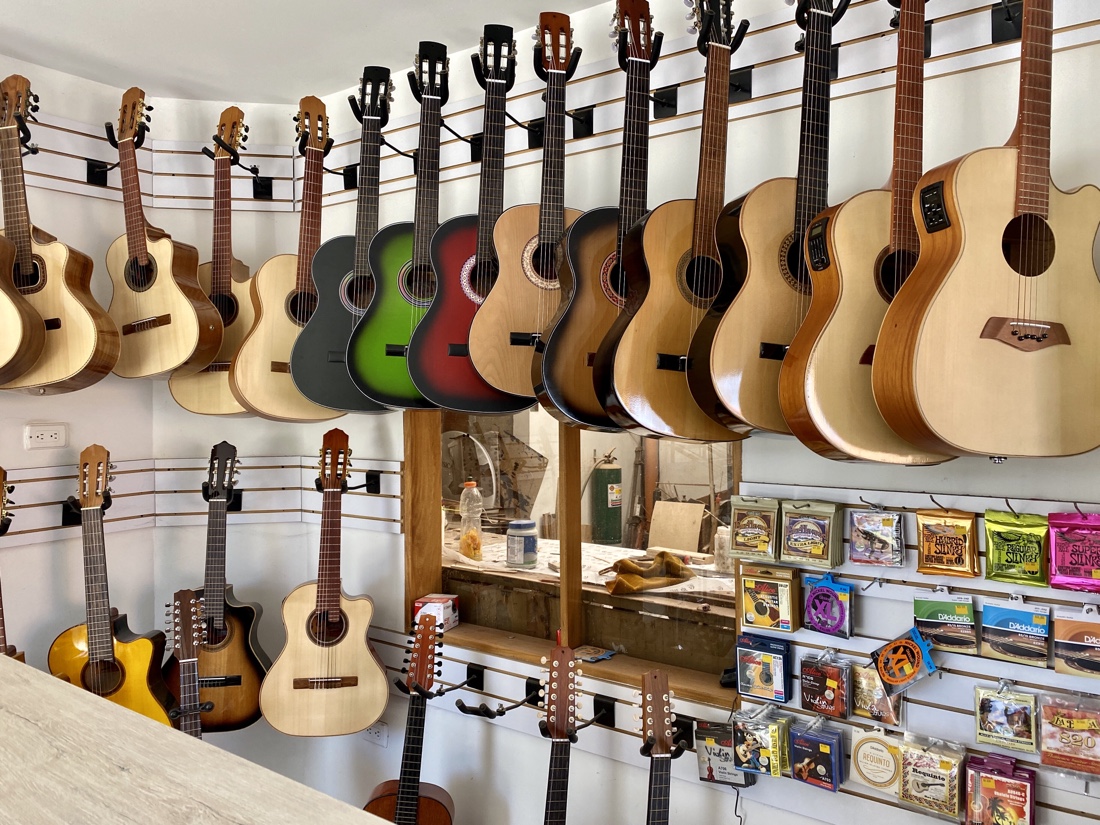 Afterwards, we drive back to Cannúa and Brian gives us a quick tour of the brick factory they built on his property of which he is very proud, because of its favorable impact on the environment. Afterwards, we drive back to Cannúa and Brian gives us a quick tour of the brick factory they built on his property of which he is very proud, because of its favorable impact on the environment.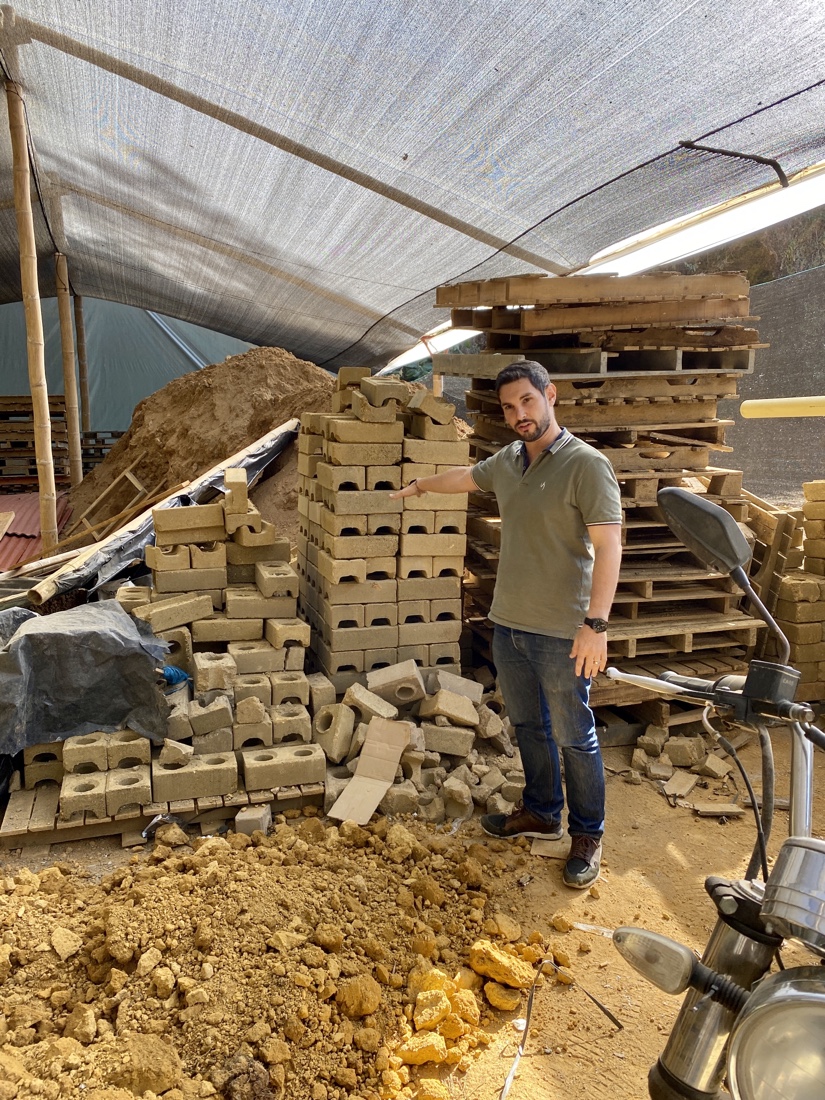 After taking a little time to relax, Carol and I have massages. After all, it’s been a tough day. After taking a little time to relax, Carol and I have massages. After all, it’s been a tough day.
We have a terrific and very creative chef’s tasting menu. Bit chilly, but they bring a pancho and pillows to make the chair backs more comfortable. Very cute waitress.
Another quite delightful and unusual day.
February 3.
After breakfast, we head to the airport. I’ve noticed that airports aren’t that much fun, even when things go pretty well. Very short line to check in at the Bogotá airport. We’ve been tipped off by Federico which door to enter which saves us a potentially very long walk. Short line for baggage inspection, but difficulties start when I tell them I’m not going to take my belt off, because my pants will fall down. This sets off a chain reaction that requires the Secretary of Transportation of Colombia fly in to okay my going through.
We go to our gate and sit, waiting for our flight until, ten minutes later, I realize that in all the fuss over my belt, I forgot to take my damn bag, I head back to the baggage clearance place and see my bag just waiting, but when I go to pick it up, a security guy stops me and begins talking in Spanish. When I tell him I can’t understand, he takes out his phone and using Google translate says that I need to identify two things that are packed in the bag so that he knows it is mine. I do that, get the bag and walk back to our gate, where I join Carol. Ten minutes later, I look up at a monitor and discover that our gate is no longer our gate, so we go to our new our gate, which is not very far away from our old our gate.
Finally, we board our plane and wait over an hour and a half for “a part.” I’m a little bored, so here’s a shot of the guy in front of me.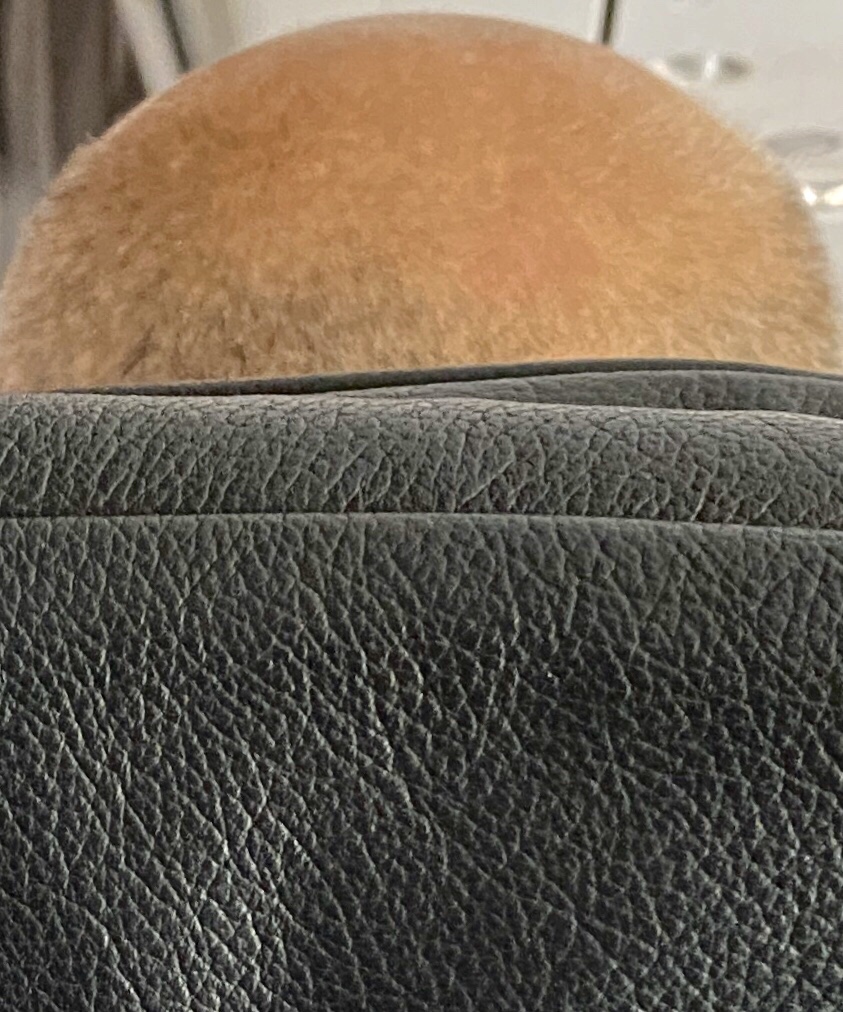
Once we take off, it’s a 45-minute flight to the “City of Eternal Spring,” Medellín. We are met at the Medellin airport by Brian and transported to the Andes mountains.
Just outside Medellín in the peaceful town of Santa Elena we encounter a treasure of a different kind: fields of flowers! The vast majority of flowers that are purchased in the United States for Valentine’s Day are grown right here in this region and, later in the day, we visit an enormous flower farm to learn about flower production and the cultivation process of export-quality flowers.
We start the afternoon with a truly special and rare treat: visiting the house of a family that has been participating for 42 years in Medellín’s world famous Flower Festival as “sillateros.” Sillateros carry enormous flower displays, which may weigh over 200 pounds, for nearly 4 kilometers on their backs in remembrance of the times of colonial slavery. We hear all about the tradition and the huge flower festival in early August in Medellin from a woman who has participated for 42 years herself, learning about all the rules and restrictions, watching her put together a flower arrangement from scratch and seeing some of the many ribbons she has won. She talks with great energy and enthusiasm, as Brian translates.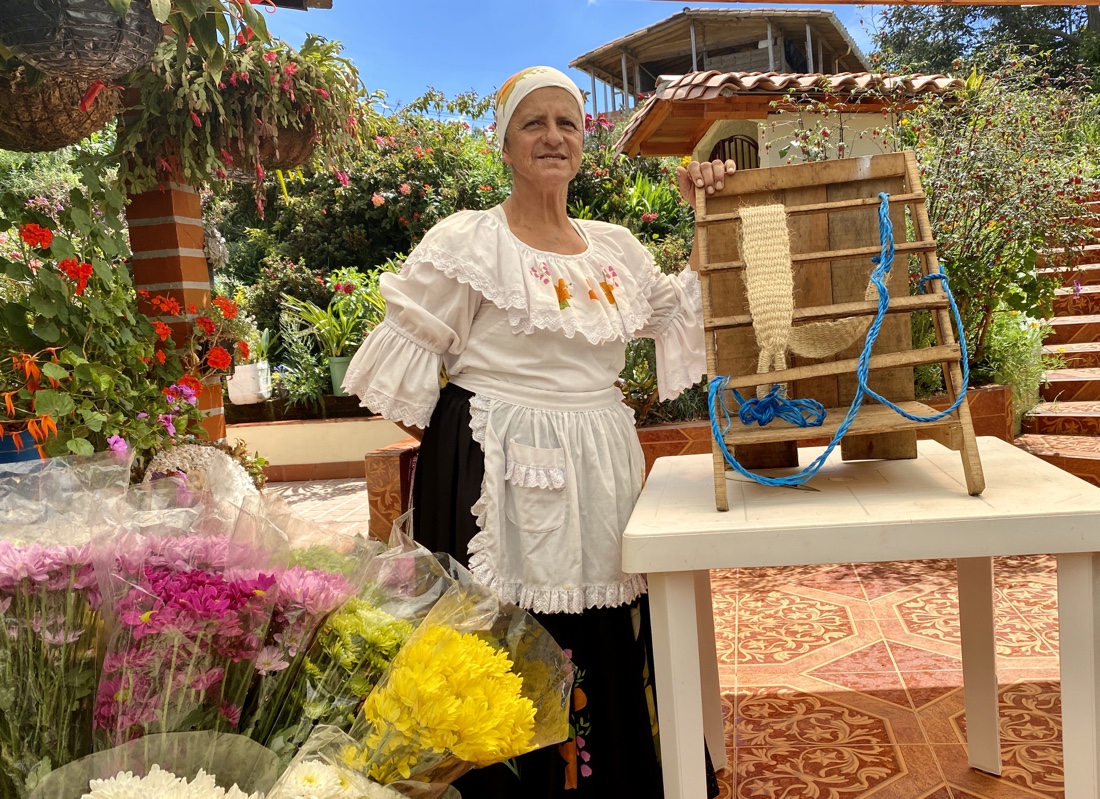 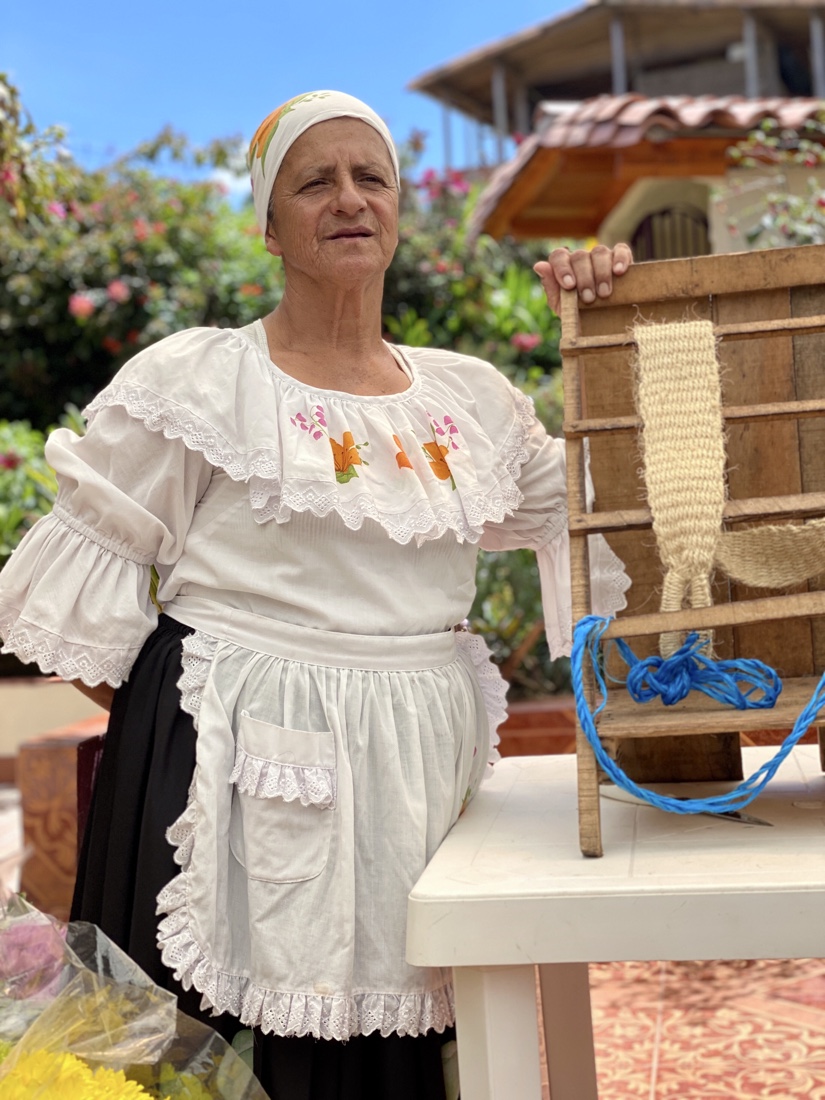 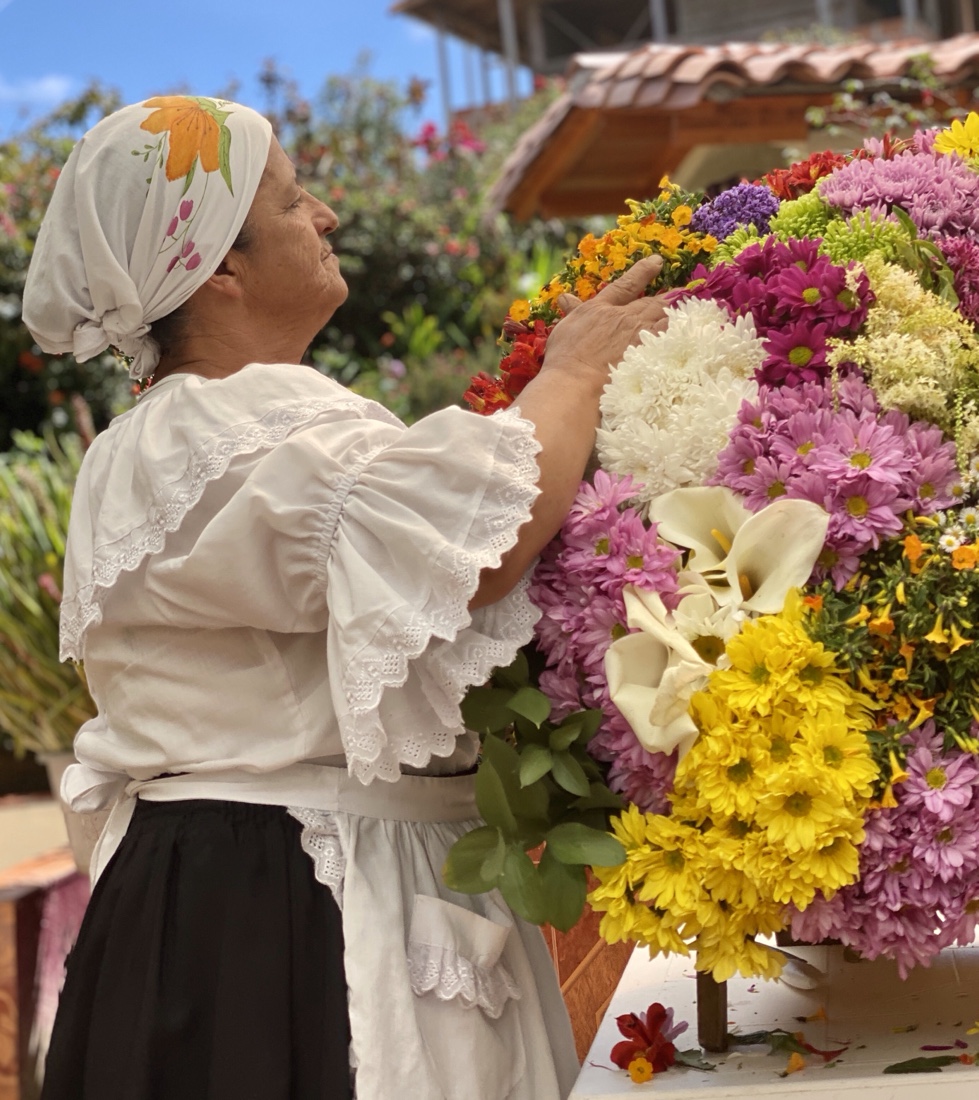 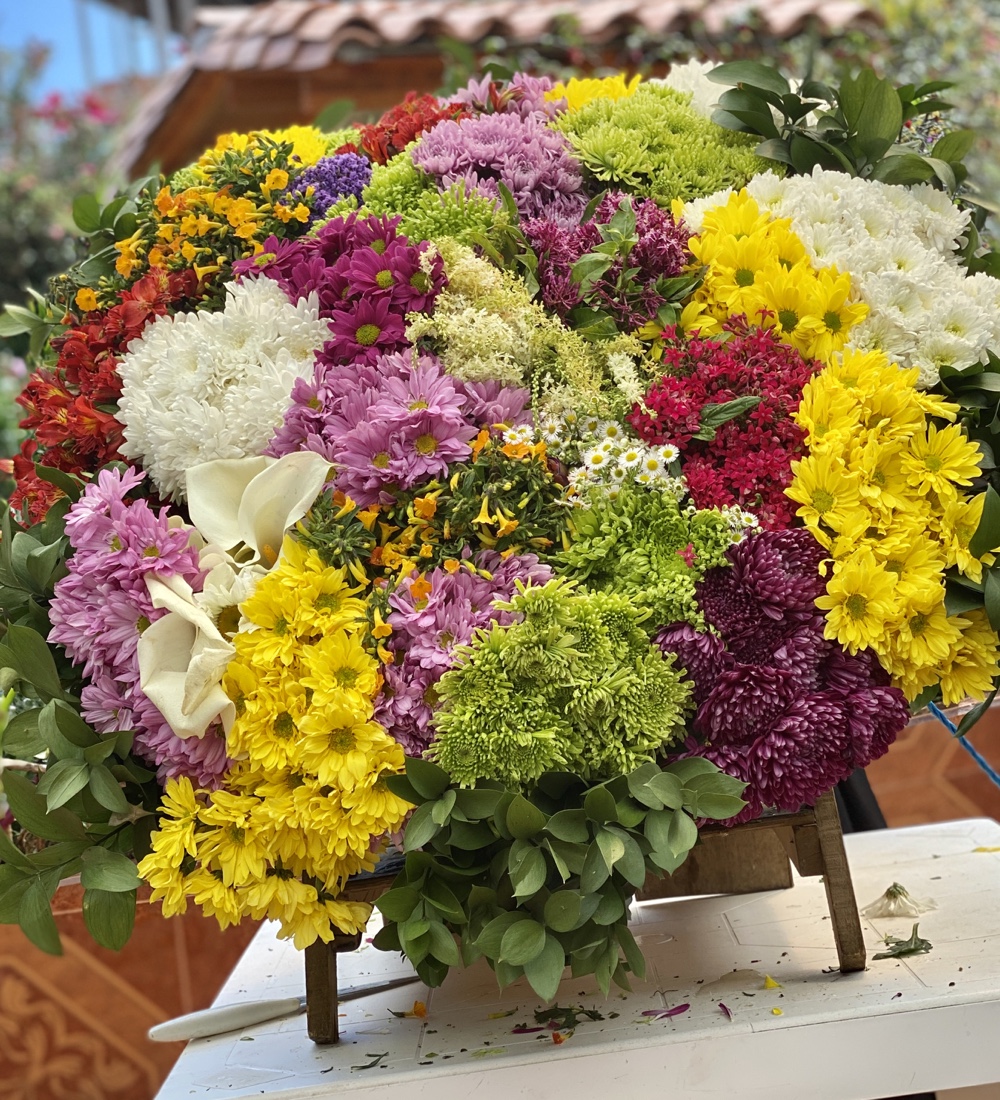 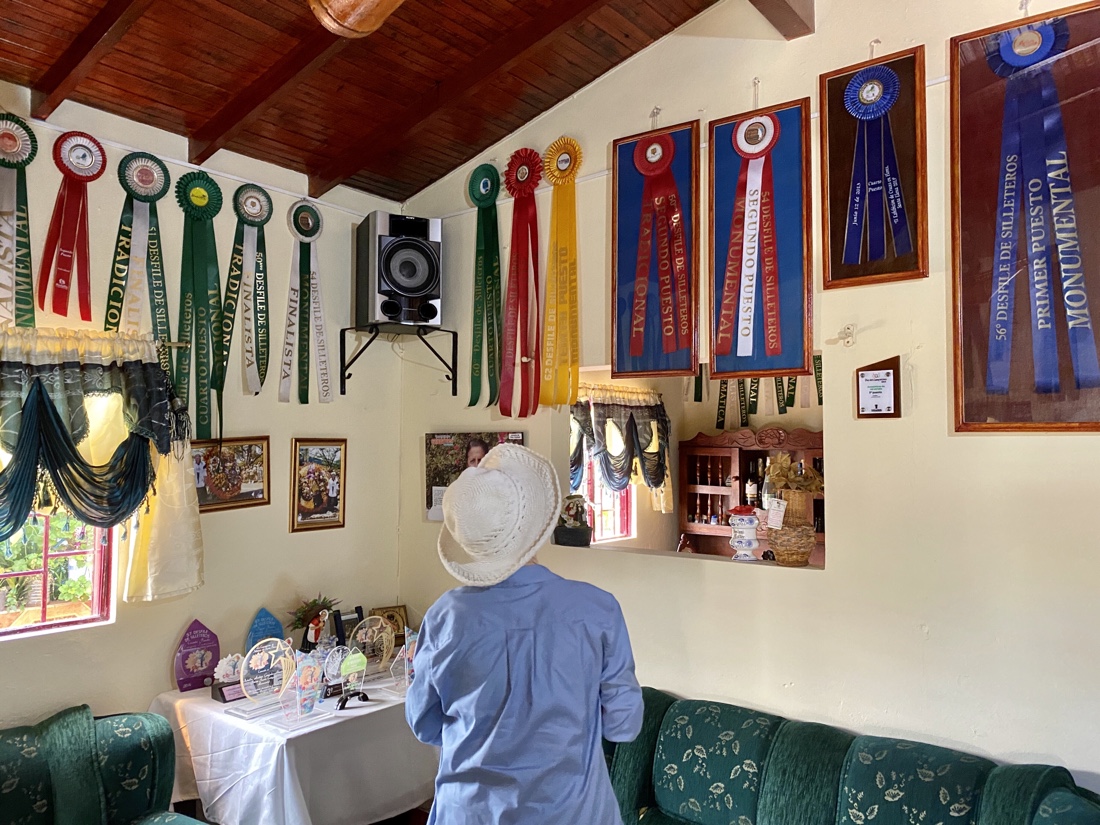 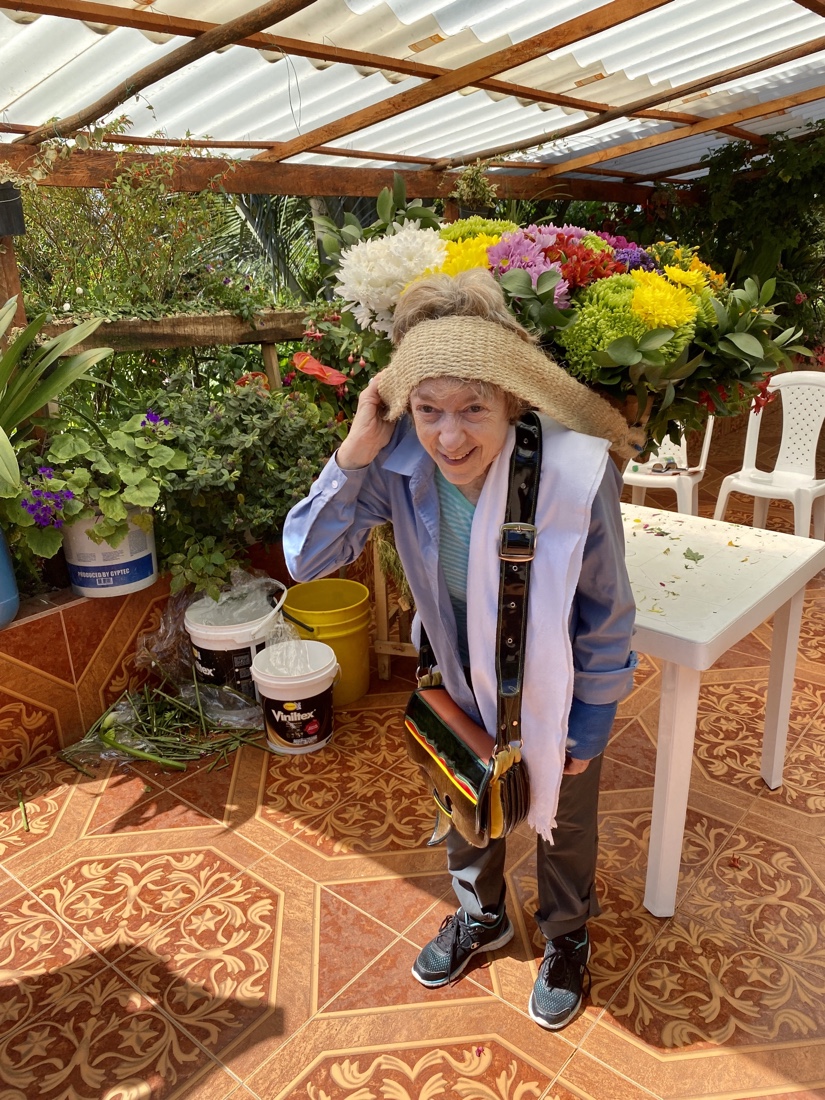 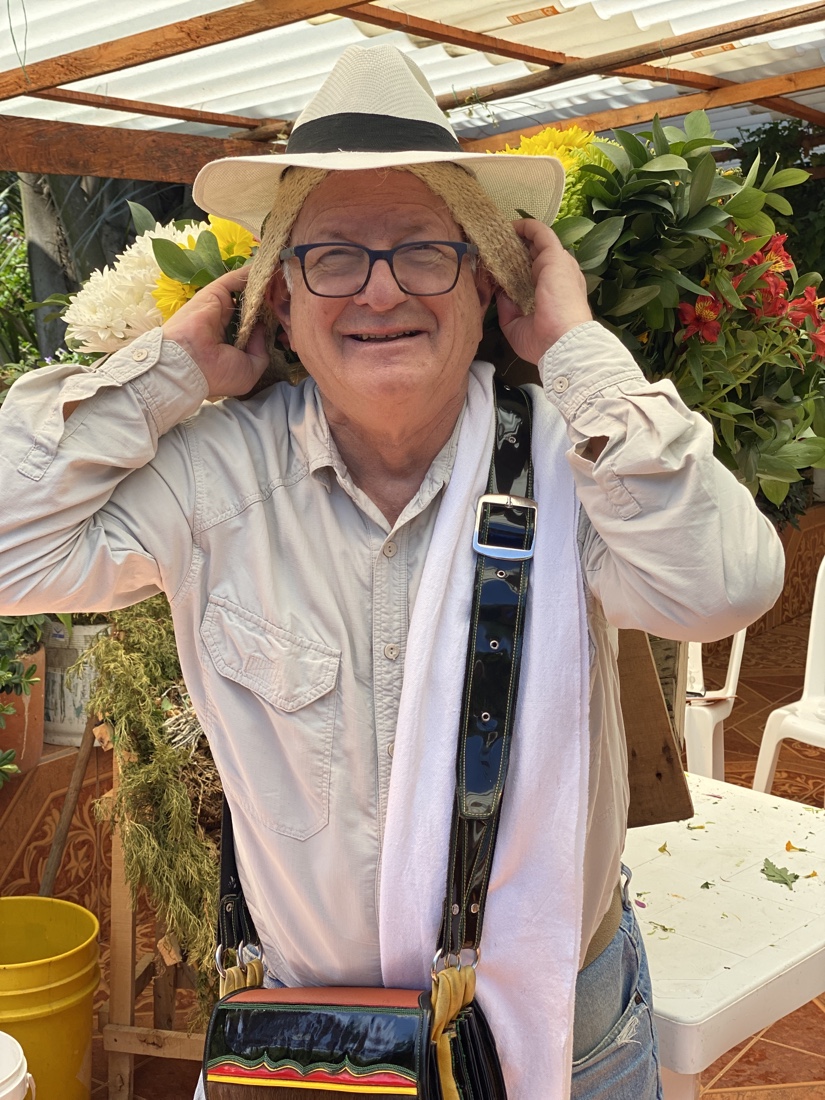
We continue on to a large flower farm, where we are served an excellent lunch. We are then shown around the farm by the son-in-law of the owner and hear about and see all aspects of the flower farming process and see the large variety of succulent plants he is growing, all of which is quite fascinating. Both Carol and I underestimated the son-in-law when we first met him (Brian confessed later that he’d done the same, that the fellow looked sort of like a homeless guy), but we later became very impressed with his determination, attention to detail and creativity. We walk around quite a lot, so my walking sticks come in very handy. The weather is lovely in the sun, but chilly in the shade because of the altitude and rain..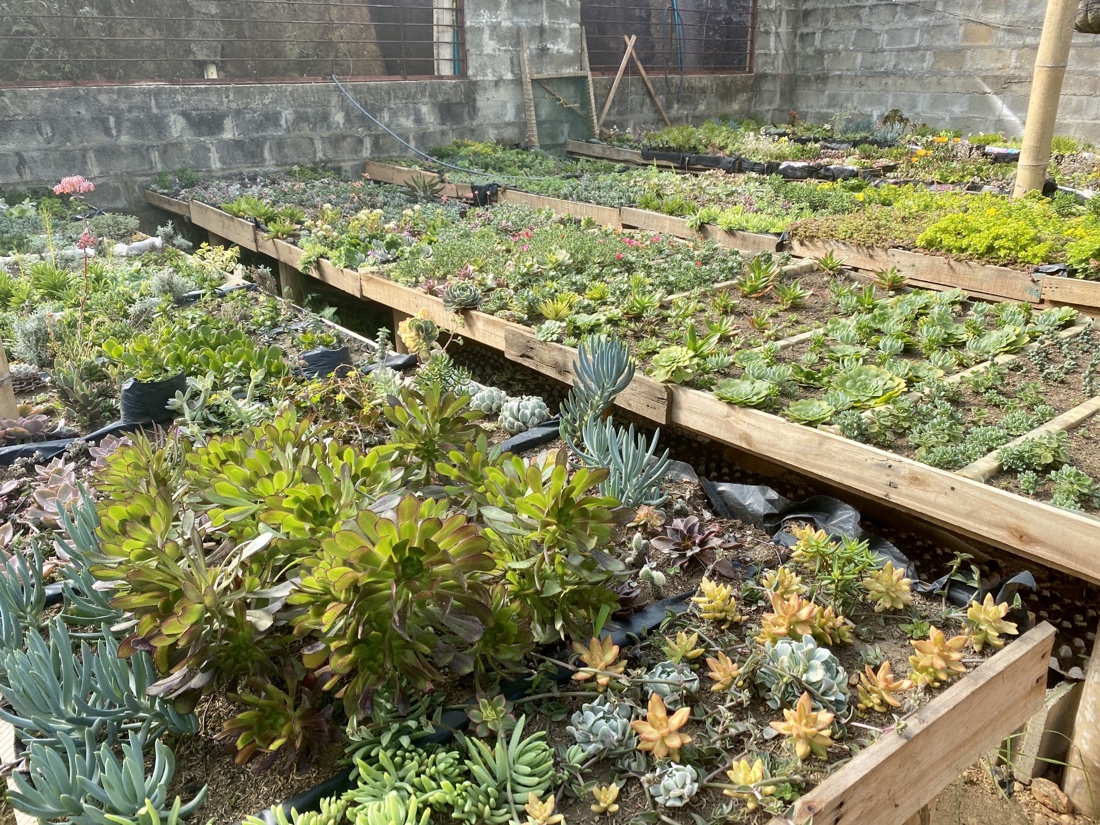 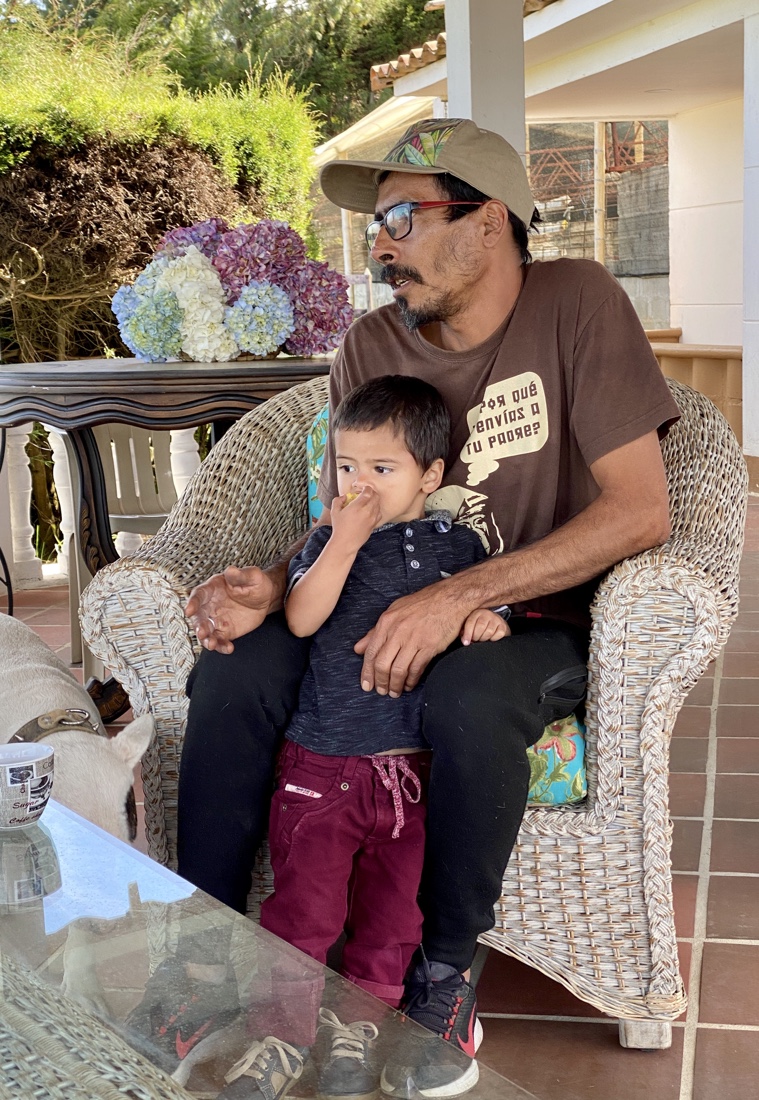  
Afterwards, we are shuttled over to Cannúa, Colombia’s very first sustainable, boutique, luxury ecolodge. The impressive project is designed from the ground up based on permaculture principles and is a leader in ushering in the future of responsible tourism. Brian is justifiably proud of what he has created and the values it fully embodies.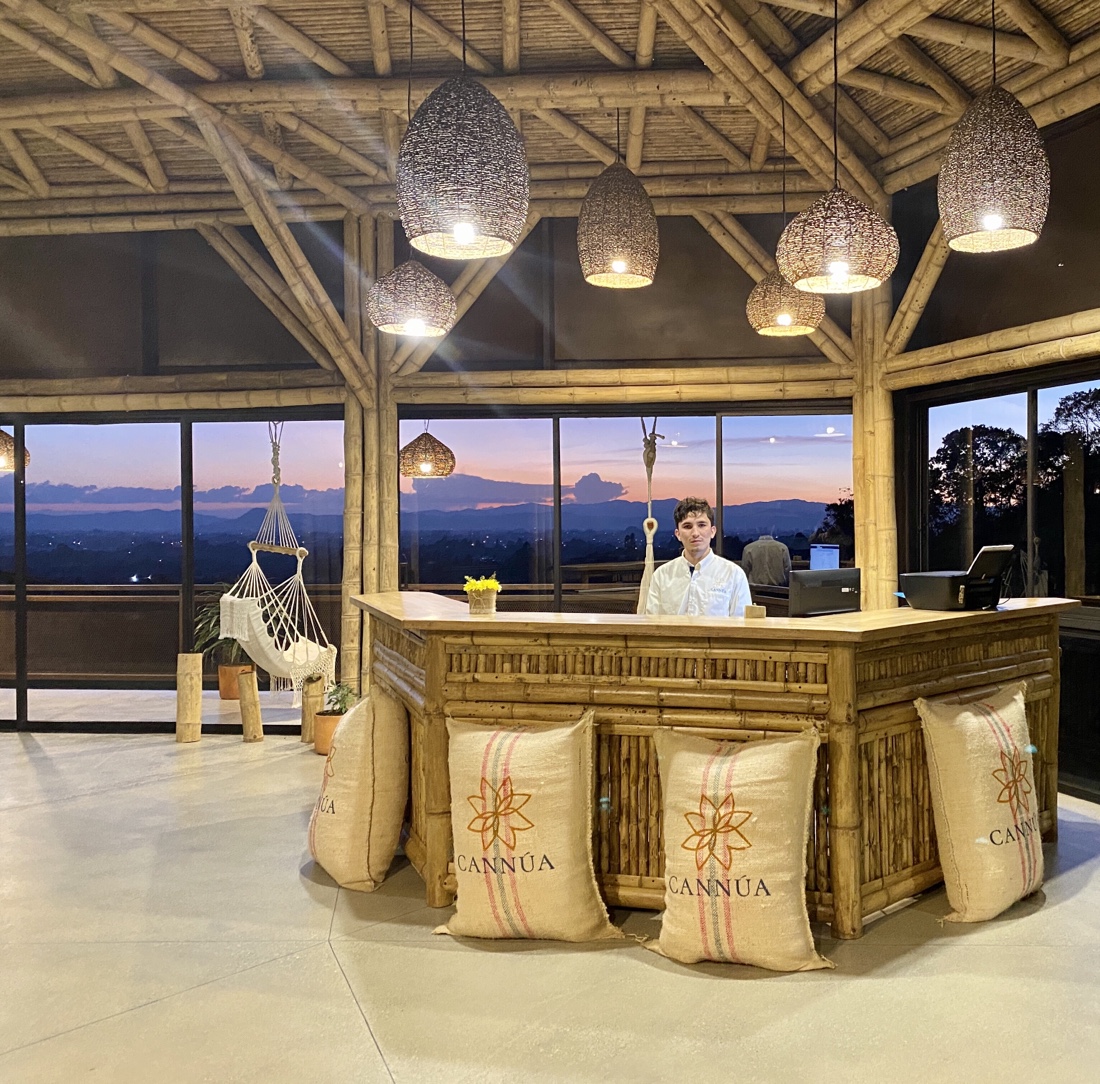
We go back to our very comfortable room and relax a bit before dinner. Brian has given us a choice between a deluxe cabin and a room in the lodge. We choose the latter as more convenient.
We have a very good dinner at the hotel, Brian popping in and out, as his other duties permit. The staff is young, friendly and attractive. We retire rather early, hoping for a good night’s sleep.
Very interesting day. We’re certainly not in Kansas (Bogotá) any more, and the change is refreshing.
|
|
 As we walk part way up the walls of the fort we can understandwhy, despite several attempts by outside forces, the Castillo de San Felipe was never taken and always successfully defended. It is extremely hot out, so, mercifully, we are able to stop at an air conditioned room that has a quite interesting film about the construction and history of the fort.
As we walk part way up the walls of the fort we can understandwhy, despite several attempts by outside forces, the Castillo de San Felipe was never taken and always successfully defended. It is extremely hot out, so, mercifully, we are able to stop at an air conditioned room that has a quite interesting film about the construction and history of the fort.
 Cartagena clearly has more hats for sale per capita than any city we’ve seen.
Cartagena clearly has more hats for sale per capita than any city we’ve seen. Juan Camilo tells us rather more than we care to hear about the history of the area, and some of the spots we were to see were not open. We do stop at a nice coffee shop, which reportedly has won more prizes for its coffee than any other, then return to our hotel, ready to call it a day. We are shown to our suite, which is very lovely, superior by far to the presidential suite at the Park 10 in Medellin.
Juan Camilo tells us rather more than we care to hear about the history of the area, and some of the spots we were to see were not open. We do stop at a nice coffee shop, which reportedly has won more prizes for its coffee than any other, then return to our hotel, ready to call it a day. We are shown to our suite, which is very lovely, superior by far to the presidential suite at the Park 10 in Medellin.



 En route to our destination, we pass through some small towns.
En route to our destination, we pass through some small towns.




 Over 120 years ago, the very first commercial coffee cultivations in Colombia were planted in this beautiful finca (farm) in San Cayetano, which today produces some of the best traditional coffee in the country.
Over 120 years ago, the very first commercial coffee cultivations in Colombia were planted in this beautiful finca (farm) in San Cayetano, which today produces some of the best traditional coffee in the country.  San Cayetano is Rainforest Alliance certified for their conscienscious treatment of the earth and UTZ fair trade certified for fair treatment of their employees.
San Cayetano is Rainforest Alliance certified for their conscienscious treatment of the earth and UTZ fair trade certified for fair treatment of their employees.



 As the sun sets, we sit on the deck, reading and blogging.
As the sun sets, we sit on the deck, reading and blogging. 





 We stop for coffee with Ana at a place where people used to to come to tango and which is unchanged from the 1930s, old juke boxes and phonographs still in tact.
We stop for coffee with Ana at a place where people used to to come to tango and which is unchanged from the 1930s, old juke boxes and phonographs still in tact.




 We are then told about the history of the creation of the school by Daniella, the daughter of the founder we will meet this evening, who works full time without pay for the Amadeus Foundation which supports the school. Daniella is totally delightful and passionate about the schools for work and articulate about its goals.
We are then told about the history of the creation of the school by Daniella, the daughter of the founder we will meet this evening, who works full time without pay for the Amadeus Foundation which supports the school. Daniella is totally delightful and passionate about the schools for work and articulate about its goals.  We tell her about FreshLens, the program that Carol and I have gotten involved in that teaches photography to under resourced children. There is a strong parallel between the music school and FreshLens, though the former requires a far greater commitment on the part of students. They come five days a week for five hours a day after attending regular school during the morning.
We tell her about FreshLens, the program that Carol and I have gotten involved in that teaches photography to under resourced children. There is a strong parallel between the music school and FreshLens, though the former requires a far greater commitment on the part of students. They come five days a week for five hours a day after attending regular school during the morning.















 Afterwards, we drive back to Cannúa and Brian gives us a quick tour of the brick factory they built on his property of which he is very proud, because of its favorable impact on the environment.
Afterwards, we drive back to Cannúa and Brian gives us a quick tour of the brick factory they built on his property of which he is very proud, because of its favorable impact on the environment. After taking a little time to relax, Carol and I have massages. After all, it’s been a tough day.
After taking a little time to relax, Carol and I have massages. After all, it’s been a tough day.












